2018-01-18 - Nº 142

Editorial
Esta é a Newsletter Nº 142 que se apresenta com o mesmo formato que as anteriores. Se gostar da Newsletter partilhe-a!
Todas as Newsletters encontram-se indexadas no link.
Esta Newsletter tem os seguintes tópicos:
Faz hoje anos que nascia, em 1799, Joseph Dixon. Este inventor norte-americano foi pioneiro no uso industrial de grafite e muitas outras inovações. Como impressor e fotógrafo, ele projectou um espelho numa câmara que foi o precursor do visor, patenteou uma máquina a vapor de duas manivelas, desenvolveu um método de impressão de notas para falsificadores de papelão. Como fabricante e empresário, Joseph Dixon produziu o primeiro lápis feito nos EUA, 2 de Abril de 1827, e foi responsável pelo desenvolvimento da indústria de grafite.
Faz também anos hoje que nascia, em 1813, Joseph Glidden. Este inventor norte-americano, nascido em Charlestown - New Hampshire, era um fazendeiro de Illinois quando desenvolveu o design do primeiro arame farpado comercial, um produto que transformaria o Ocidente. Antes dessa inovação, os colonos das planícies sem árvores não tinham meios fáceis de cercar os animais longe das terras cultivadas, e os fazendeiros não tinham como evitar que seus rebanhos vagueassem por toda parte. O arame farpado de Glidden abriu as planícies para a agricultura em grande escala e fechou o campo aberto, levando a era do vaqueiro ao fim.
Faz igualmente anos hoje que nascia, em 1825, Edward Frankland. Este químico inglês foi um dos primeiros pesquisadores no campo da química estrutural, inventou o vínculo químico e tornou-se conhecido como o pai da valência. Ele estudou compostos organometálicos - moléculas híbridas dos conhecidos elementos orgânicos não metálicos (como carbono, hidrogénio, nitrogénio, enxofre, fósforo) com metais verdadeiros. Em 1850, preparou pequenas moléculas orgânicas contendo metais como o zinco. Posteriormente, ele desenvolveu a teoria da valência (anunciada em 10 de maio de 1852), que cada tipo de átomo possui uma capacidade fixa de combinação com outros átomos.
Nesta data faz igualmente anos que nascia, em 1829, Ludvig Lorenz. Este físico e matemático dinamarquês desenvolveu fórmulas matemáticas para descrever fenómenos como a relação entre a refracção da luz e a densidade de uma substância transparente pura e a relação entre a condutividade e temperatura térmica e térmica de um metal (lei Wiedemann-Franz-Lorenz).
Faz também anos hoje que nascia, em 1861, Hans Goldschmidt. Este químico alemão inventou o processo térmite (alumino-termico) que foi adoptado mundialmente para soldar as linhas ferroviários e que ainda está em uso para soldagem no local. A primeira linha soldada desta forma foi colocada em Essen. Este método evoluiu a partir de seu processo de redução Goldschmidt que ele começou a investigar em 1893 para a preparação de metais isentos de carbono. Ele usou as reacções de óxidos de certos metais com alumínio para produzir óxido de alumínio e o metal livre. Foi aplicado para separar cromo, manganês e cobalto dos seus minerais de óxido. Goldschmidt também foi um co-inventor de amálgama de sódio.
Faz igualmente anos hoje que nascia, em 1888, Thomas Sopwith. Este desenhador e fabricante de aeronaves inglês, ficou famoso pela sua empresa pioneira que era famosa pela aeronave militar britânica da Primeira Guerra Mundial. O interesse de Sopwith em automobilismo levou em 1910 a pilotar um mono-plano, com o qual ganhou o Prémio Baron de Forest por voar pelo Canal da Mancha a 18 de Dezembro de 1910. Em Junho de 1912, Sopwith com Fred Sigrist e outros criaram The Sopwith Aviation Company e começou a fabricar o biplano Sopwith Tabloid. Pilotado por Harry Hawker, este avião ganhou o registo de altitude britânico de 4.000 metros no 16 de junho de 1913. Durante a Primeira Guerra Mundial, a empresa fabricou alguns dos melhores aviões aliados, incluindo o lendário Sopwith Camel, o Sopwith Pup e o Sopwith Snipe.
Por fim, faz anos hoje que nascia,em 1933, Ray Dolby. Este físico e engenheiro norte-americano ficou conhecido pela invenção dos sistemas de redução de ruído Dolby. Dolby é famoso por inovações que vão desde as cassetes de alta qualidade que foram usadas nos estéreo dos carro até ao mais recente som surround digital em salas de cinema. Como estudante do ensino médio, ele foi trabalhar a tempo parcial para a Ampex Corporation. Enquanto ainda na faculdade, ele juntou-se à pequena equipa de engenheiros da Ampex dedicados a inventar o primeiro gravador de fita prático do mundo, o Ampex VTR (1956). Em 1965, Dolby fundou sua própria empresa - a Dolby Laboratories. O seu primeiro desenvolvimento foi a redução de ruído do tipo Dolby A, uma compressão e expansão de áudio que reduziu drasticamente o silvo de fundo na gravação de fita profissional sem efeitos colaterais perceptíveis.
Na semana que passou ficámos a saber que a Planetary Resources, empresa de mineração espacial apoiada pelo Google Larry Page e o fundador da Braintree, Bryan Johnson, deu outro passo em sua busca para realmente minerar recursos de asteróides e outros corpos celestes. A empresa lançou com sucesso o seu Arkyd-6 CubeSat, que possui uma tecnologia experimental projectada para detectar recursos hídricos no espaço. A Planetary Resources já está a receber telemetria da nave espacial, e a empresa acredita que a tecnologia experimental é um passo decisivo para que ela desenvolva sua próxima plataforma espacial, o Arkyd-301.
Também esta semana ficámos a saber que a Nintendo vai lançar uma linha de experiências interactivas associadas à sua consola mais recente, a Switch. Esta linha designada por Labo foi projectada para inspirar crianças e aqueles que são crianças de coração. Com base na história de 129 anos da Nintendo, que está enraizada em entretenimento inovador e experiências de jogo, a Nintendo Labo continua a missão da empresa de colocar sorrisos nos rostos das pessoas. Em conjunto com o sistema Nintendo Switch, os kits da Nintendo Labo fornecem as ferramentas e a tecnologia para fazer criações DIY divertidas, jogar jogos com suas criações e DESCOBRIR como a magia da tecnologia Nintendo Switch transforma ideias em realidade.
Por fim, a NASA anunciou que, com dados obtidos pela sonda Cassini é possível assumir que na lua Titã de Saturno os seus mares se encontram, como na Terra, a uma elevação média que chamamos de "nível do mar". Esta é a última descoberta que mostra semelhanças notáveis entre a Terra e o Titã, o único outro mundo que conhecemos no nosso sistema solar que possui líquido estável na sua superfície. No entanto, em Titã, os seus lagos e mares estão cheios de hidrocarbonetos, em vez de água líquida, e o gelo de água coberto por uma camada de material orgânico sólido serve como a rocha que envolve esses lagos e mares.
Na Newsletter desta semana apresentamos diversos projetos de maker. São apresentados 5 livros "GNU/Linux Command-Line Tools Summary", "Bash Reference Manual - Reference Documentation for Bash 4.4", "Bash Guide for Beginners", "Advanced Bash-Scripting Guide" e "The AWK Programming Language".
 João Alves ([email protected])
João Alves ([email protected])
O conteúdo da Newsletter encontra-se sob a licença  Creative Commons Attribution-NonCommercial-ShareAlike 4.0 International License.
Creative Commons Attribution-NonCommercial-ShareAlike 4.0 International License.
Novidades da Semana
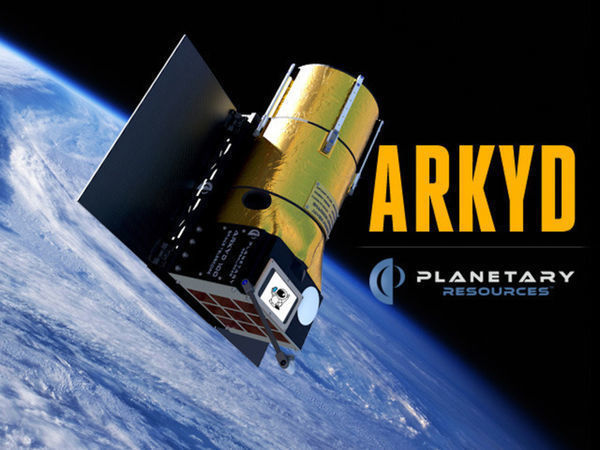
Larry Page-backed asteroid mining company launches CubeSat with experimental water detection tech
"Planetary Resources, the space mining company backed by Google’s Larry Page and Braintree founder Bryan Johnson, has taken another step in its quest to actually mine resources from asteroids and other planetary bodies. The company successfully launched its Arkyd-6 CubeSat, which is holding an experimental technology designed to detect water resources in space. Planetary Resources is already receiving telemetry from the spacecraft, and the company believes that the experimental technology is a critical stepping-stone for it to develop its next spacecraft platform the Arkyd-301. That technology is what Planetary Resources will use to launch its space resource exploration in earnest the company said. The company’s plans for space mining have been met with skepticism (and some amount of ridicule), with many terrestrial analysts claiming that the company’s costs far outweigh any benefits that could arise from mining asteroids. Indeed, in the company’s earliest days it made money by launching satellites that were used to monitor and collect data on earthly rather than planetary resources." [...]

Nintendo Labo combines the magic of Nintendo Switch with the fun of DIY creations
"Introducing Nintendo Labo, a new line of interactive build-and-play experiences designed to inspire kids and those who are kids-at-heart. Building on the 129-year history of Nintendo, which is rooted in innovative entertainment and game-play experiences, Nintendo Labo continues the company’s mission of putting smiles on people’s faces. Together with the Nintendo Switch system (sold separately), the Nintendo Labo kits provide the tools and technology to MAKE fun DIY creations, PLAY games with your creations and DISCOVER how the magic of Nintendo Switch technology shapes ideas into reality. With each Nintendo Labo kit, kids can transform modular sheets of cardboard – specially designed to interact with the Nintendo Switch console and Joy-Con controllers – into creations called Toy-Con. From a piano to a motorbike, a robot and more, each Toy-Con comes to life when combined with Nintendo Switch in different ways. As you build, you will have fun discovering how the technology works, and might even invent new ways to play with each Toy-Con!" [...]

Cassini Finds Saturn Moon Has 'Sea Level' Like Earth
"Saturn’s moon Titan may be nearly a billion miles away from Earth, but a recently published paper based on data from NASA’s Cassini spacecraft reveals a new way this distant world and our own are eerily similar. Just as the surface of oceans on Earth lies at an average elevation that we call “sea level,” Titan’s seas also lie at an average elevation. This is the latest finding that shows remarkable similarities between Earth and Titan, the only other world we know of in our solar system that has stable liquid on its surface. The twist at Titan is that its lakes and seas are filled with hydrocarbons rather than liquid water, and water ice overlain by a layer of solid organic material serves as the bedrock surrounding these lakes and seas. The new paper, led by Alex Hayes at Cornell University in Ithaca, New York, and published in the journal Geophysical Research Letters, finds that Titan’s seas follow a constant elevation relative to Titan’s gravitational pull -- just like Earth’s oceans. Smaller lakes on Titan, it turns out, appear at elevations several hundred feet, or meters, higher than Titan’s sea level." [...]
Outras Notícias
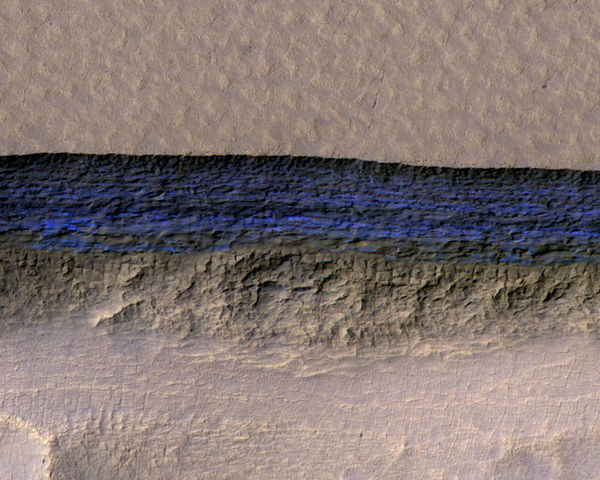
Steep Slopes on Mars Reveal Structure of Buried Ice
"Researchers using NASA's Mars Reconnaissance Orbiter (MRO) have found eight sites where thick deposits of ice beneath Mars' surface are exposed in faces of eroding slopes. These eight scarps, with slopes as steep as 55 degrees, reveal new information about the internal layered structure of previously detected underground ice sheets in Mars' middle latitudes. The ice was likely deposited as snow long ago. The deposits are exposed in cross section as relatively pure water ice, capped by a layer one to two yards (or meters) thick of ice-cemented rock and dust. They hold clues about Mars' climate history. They also may make frozen water more accessible than previously thought to future robotic or human exploration missions." [...]
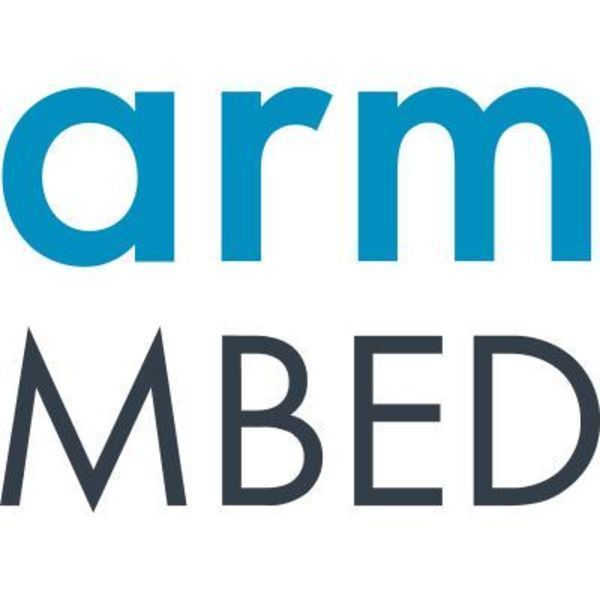
Mbed OS 5.7.3 released
"We are pleased to announce the Mbed OS 5.7.3 release is now available. This is the latest patch release based on the feature set introduced by Mbed OS 5.7. Summary We have added support for two new targets in this release, MTB ublox ODIN W2 and NUCLEO-F413ZH. ST CUBE for the STM32F0 series has been updated to v1.9.0. This brings: Current ST Cube version in MBED: V1.7.0 CMSIS part update from 2.3.1 to 2.3.3 HAL part update from 1.5.0 to 1.7.0 Our BLE Nordic PAL client implementation has been replaced. The previous implementation was found to contain a number of issues deep in the GattClient logic (improper queueing and order of operations)." [...]
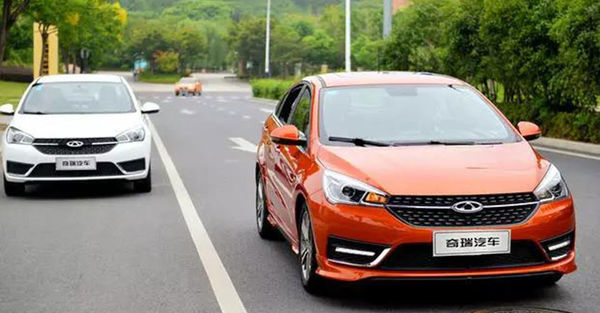
Chinese Automaker Chery to Use NVIDIA-Powered ZF ProAI for Level 3 Autonomous Cars
"Chery, one of China’s leading automakers, is adopting the new ZF ProAI system, powered by NVIDIA DRIVE AI self-driving technology, to bring Level 3 autonomous driving to the world’s biggest auto market. The news was announced today at the North American International Auto Show, in Detroit, by Konstantin Sauer, CEO of ZF, one of the world’s biggest auto parts suppliers. Chery, which makes cars, minivans and SUVs, will be the first Chinese carmaker to adopt the new ZF ProAI system, developed by NVIDIA, Baidu and ZF. For over two decades, Chery has been making vehicles for the Chinese market, as well as for more than 80 countries globally. The company has earned a reputation for bringing advanced technologies to its highly affordable, entry-level models. “This collaboration will democratize autonomous driving functions in one of the most important automotive markets of the world and bring autonomous driving for everyone,” said Sauer." [...]

BlackBerry Launches Game Changing Cybersecurity Product: BlackBerry Jarvis
"In a keynote address at the North American International Automotive Show (NAIAS), BlackBerry Limited (NYSE: BB; TSX: BB) Executive Chairman and CEO, John Chen, today unveiled BlackBerry Jarvis, a transformational software cybersecurity product. BlackBerry is initially marketing this solution to automakers, whose complex software supply chains create compelling and urgent use cases that Jarvis can help solve today. BlackBerry also noted that Jarvis is applicable to other industry segments, citing healthcare, industrial automation, aerospace, and defense as examples of other fields with immediate need for this product. Built on the company’s decades of cybersecurity expertise and proprietary technology, Jarvis is a one-of-its-kind cloud-based static binary code scanning solution that identifies vulnerabilities in software used in automobiles. Jarvis scans and delivers deep actionable insights in minutes, what would otherwise involve manually scanning that will take large numbers of experts and an impractical amount of time. “Connected and autonomous vehicles require some of the most complex software ever developed, creating a significant challenge for automakers who must ensure the code complies with industry and manufacturer-specific standards while simultaneously battle-hardening a very large and tempting attack surface for cybercriminals,” said John Chen, Executive Chairman and CEO, BlackBerry." [...]

Panasonic Conducts Demonstration Experiment of Autonomous Signage Robot, "HOSPI(R)" at Narita Airport
"Panasonic Corporation is conducting the first demonstration experiment in an airport of the autonomous signage robot, "Signage HOSPI" from January 15, 2018 with the cooperation of the Narita Airport Corporation. "Signage HOSPI" is an autonomous robot "HOSPI(R)" equipped with 3 displays on its body, and it will navigate itself through designated areas. By utilizing the ability to detect people, objects, etc. and autonomously reduce speed, stop, and avoid any such obstacles, as well as its attention-grabbing design, the experiment will explore the potential of using the robot to communicate information about items not allowed on board and as an advertising medium. The experiment will quantitatively measure the number of views the robot and stationary digital signage receive to compare and determine which is more visible, and also establish a way to evaluate the value of the signage robot. This undertaking by the Narita Airport Corporation was submitted to and adopted by the Ministry of Economy, Trade and Industry as its project, and the robot's mobility technology (the ability to move around in a large area with many people while recognizing its location) is the fruit of the project undertaken by Panasonic with the New Energy and Industrial Technology Development Organization." [...]

Samsung Electronics Starts Producing Industry's First 16-Gigabit GDDR6 for Advanced Graphics Systems
"Samsung Electronics, the world leader in advanced memory technology, today announced that it has started mass production of the industry’s first 16-gigabit (Gb) Graphics Double Data Rate 6 (GDDR6) memory for use in advanced graphics processing for gaming devices and graphics cards as well as automotive, network and artificial intelligence systems. “Beginning with this early production of the industry’s first 16Gb GDDR6, we will offer a comprehensive graphics DRAM line-up, with the highest performance and densities, in a very timely manner,” said Jinman Han, senior vice president, Memory Product Planning & Application Engineering at Samsung Electronics. “By introducing next-generation GDDR6 products, we will strengthen our presence in the gaming and graphics card markets and accommodate the growing need for advanced graphics memory in automotive and network systems. Built on Samsung’s advanced 10-nanomter (nm) class* process technology, the new GDDR6 memory comes in a 16Gb density, which doubles that of the company’s 20-nanometer 8Gb GDDR5 memory. The new solution performs at an 18-gigabits-per-second (Gbps) pin speed with data transfers of 72 gigabytes per second (GBps), which represents a more than two-fold increase over 8Gb GDDR5 with its 8Gbps pin speed. Using an innovative, low-power circuit design, the new GDDR6 operates at 1.35V to lower energy consumption approximately 35 percent over the widely used GDDR5 at 1.55V." [...]
Ciência e Tecnologia

Nanostructured Gate Dielectric Boosts Stability of Organic Thin-Film Transistors
"A nanostructured gate dielectric may have addressed the most significant obstacle to expanding the use of organic semiconductors for thin-film transistors. The structure, composed of a fluoropolymer layer followed by a nanolaminate made from two metal oxide materials, serves as gate dielectric and simultaneously protects the organic semiconductor – which had previously been vulnerable to damage from the ambient environment – and enables the transistors to operate with unprecedented stability. The new structure gives thin-film transistors stability comparable to those made with inorganic materials, allowing them to operate in ambient conditions – even underwater. Organic thin-film transistors can be made inexpensively at low temperature on a variety of flexible substrates using techniques such as inkjet printing, potentially opening new applications that take advantage of simple, additive fabrication processes. “We have now proven a geometry that yields lifetime performance that for the first time establish that organic circuits can be as stable as devices produced with conventional inorganic technologies,” said Bernard Kippelen, the Joseph M. Pettit professor in Georgia Tech’s School of Electrical and Computer Engineering (ECE) and director of Georgia Tech’s Center for Organic Photonics and Electronics (COPE). “This could be the tipping point for organic thin-film transistors, addressing long-standing concerns about the stability of organic-based printable devices.” The research was reported January 12 in the journal Science Advances." [...]

Artificial intelligence can 'evolve' to solve problems
"Many great ideas in artificial intelligence languish in textbooks for decades because we don't have the computational power to apply them. That's what happened with neural networks, a technique inspired by our brains' wiring that has recently succeeded in translating languages and driving cars. Now, another old idea—improving neural networks not through teaching, but through evolution—is revealing its potential. Five new papers from Uber in San Francisco, California, demonstrate the power of so-called neuroevolution to play video games, solve mazes, and even make a simulated robot walk. Neuroevolution, a process of mutating and selecting the best neural networks, has previously led to networks that can compose music, control robots, and play the video game Super Mario World. But these were mostly simple neural nets that performed relatively easy tasks or relied on programming tricks to simplify the problems they were trying to solve." [...]

New discovery could improve brain-like memory and computing
"University of Minnesota researchers demonstrate the existence of a new kind of magnetoresistance involving topological insulators From various magnetic tapes, floppy disks and computer hard disk drives, magnetic materials have been storing our electronic information along with our valuable knowledge and memories for well over half of a century. In more recent years, the new types phenomena known as magnetoresistance, which is the tendency of a material to change its electrical resistance when an externally-applied magnetic field or its own magnetization is changed, has found its success in hard disk drive read heads, magnetic field sensors and the rising star in the memory technologies, the magnetoresistive random access memory. A new discovery, led by researchers at the University of Minnesota, demonstrates the existence of a new kind of magnetoresistance involving topological insulators that could result in improvements in future computing and computer storage. The details of their research are published in the most recent issue of the scientific journal Nature Communications. “Our discovery is one missing piece of the puzzle to improve the future of low-power computing and memory for the semiconductor industry, including brain-like computing and chips for robots and 3D magnetic memory,” said University of Minnesota Robert F. Hartmann Professor of Electrical and Computer Engineering Jian-Ping Wang, director of the Center for Spintronic Materials, Interfaces, and Novel Structures (C-SPIN) based at the University of Minnesota and co-author of the study. Emerging technology using topological insulators While magnetic recording still dominates data storage applications, the magnetoresistive random access memory is gradually finding its place in the field of computing memory." [...]
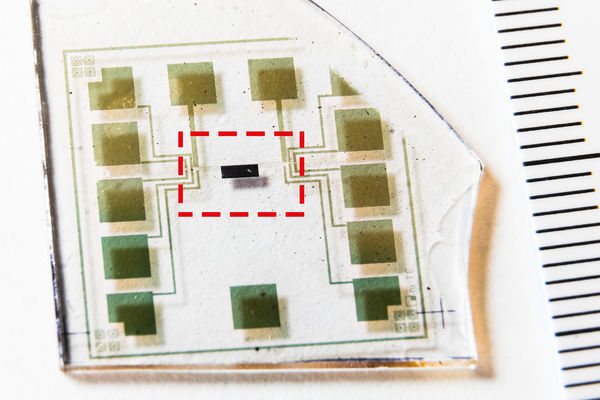
A major step forward in organic electronics
"Researchers at the Laboratory of Organic Electronics have developed the world’s first complementary electrochemical logic circuits that can function stably for long periods in water. This is a highly significant breakthrough in the development of bioelectronics. The dominating material used until now has been PEDOT:PSS, which is a p-type material, in which the charge carriers are holes. In order to construct effective electron components, a complementary material, n-type, is required, in which the charge carriers are electrons. It has been difficult to find a sufficiently stable polymer material, one that can operate in water media and in which the long polymer chains can sustain high current when the material is doped. N-type material In an article in the prestigious scientific journal Advanced Materials, Simone Fabiano, head of research in the Organic Nanoelectronics group at the Laboratory of Organic Electronics, presents, together with his colleagues, results from an n-type conducting material in which the ladder-type structure of the polymer backbone favours ambient stability and high current when doped." [...]
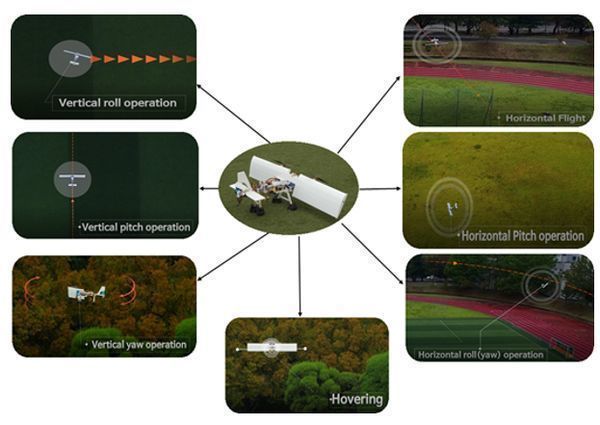
Aerial Vehicle Flying Freely with Independently Controlled Main Wings
"Professor Dongsoo Har and his team in Cho Chun Shik Graduate School of Green Transportation in Korea Advanced Institute of Science and Technology (KAIST) lately developed an aerial vehicle that is able to control the main wings separately and independently. Aerial vehicles in a typical category have main wings fixed to the body (fuselage) in an integrated form. Shape of main wings, namely airfoil, produces lift force, thanks to aerodynamic interaction with air, and achieves commensurate energy efficiency. Yet, it is difficult for them to make agile movements due to the large turn radius. Banking the aerial vehicle that accounts for eventual turn comes from the adjustment of small ailerons mounted on the trailing edge of the wings. Aerial vehicles in another typical category gain thrust power by rotating multiple propellers." [...]

Developing a secure, un-hackable net
"A method of securely communicating between multiple quantum devices has been developed by a UCL-led team of scientists, bringing forward the reality of a large-scale, un-hackable quantum network. To date, communicating via quantum networks has only been possible between two devices of known provenance that have been built securely. With the EU and UK committing €1 billion and £270 million* respectively into funding quantum technology research, a race is on to develop the first truly secure, large-scale network between cities that works for any quantum device. “We’re in a technology arms race of sorts. When quantum computers are fully developed, they will break much of today’s encryption whose security is only based on mathematical assumptions. To pre-emptively solve this, we are working on new ways of communicating through large networks that don’t rely on assumptions, but instead use the quantum laws of physics to ensure security, which would need to be broken to hack the encryption,” explained lead author, Dr Ciarán Lee (UCL Physics & Astronomy)." [...]
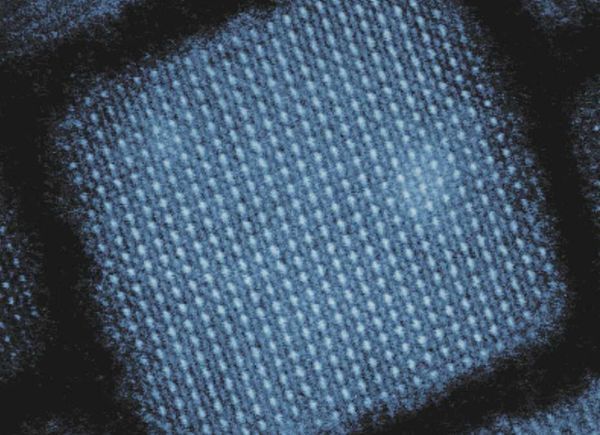
Extremely bright and fast light emission
"A type of quantum dot that has been intensively studied in recent years can reproduce light in every colour and is very bright. An international research team that includes scientists from ETH Zurich has now discovered why this is the case. The quantum dots could someday be used in light-emitting diodes. An international team of researchers from ETH Zurich, IBM Research Zurich, Empa and four American research institutions have found the explanation for why a class of nanocrystals that has been intensively studied in recent years shines in such incredibly bright colours. The nanocrystals contain caesium lead halide compounds that are arranged in a perovskite lattice structure. Three years ago, Maksym Kovalenko, a professor at ETH Zurich and Empa, succeeded in creating nanocrystals – or quantum dots, as they are also known – from this semiconductor material." [...]
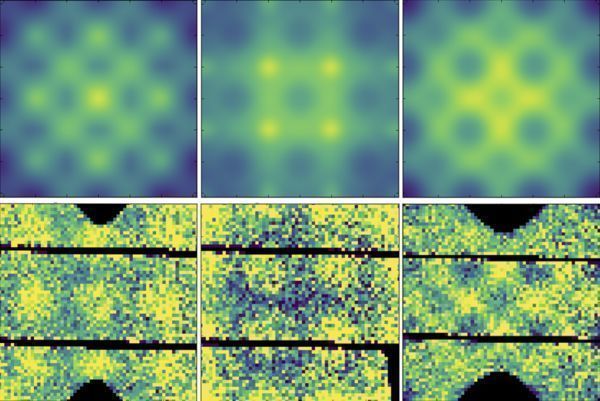
Breaking bad metals with neutrons
"By exploiting the properties of neutrons to probe electrons in a metal, a team of researchers led by the U.S. Department of Energy’s (DOE) Argonne National Laboratory has gained new insight into the behavior of correlated electron systems, which are materials that have useful properties such as magnetism or superconductivity. The research, to be published in Science, shows how well scientists can predict the properties and functionality of materials, allowing us to explore their potential to be used in novel ways. “How do you get to a stage where the models are reliable? This paper shows that we can now theoretically model even extremely complex systems. These techniques could accelerate our discovery of new materials.” — Ray Osborn, Argonne senior scientist “Our mission from the Department of Energy is to discover and then understand novel materials that could form the basis for completely new applications,” said lead author Ray Osborn, a senior scientist in Argonne’s Neutron and X-ray Scattering Group. Osborn and his colleagues studied a strongly correlated electron system (CePd3) using neutron scattering to overcome the limitations of other techniques and reveal how the compound’s electrical properties change at high and low temperatures." [...]
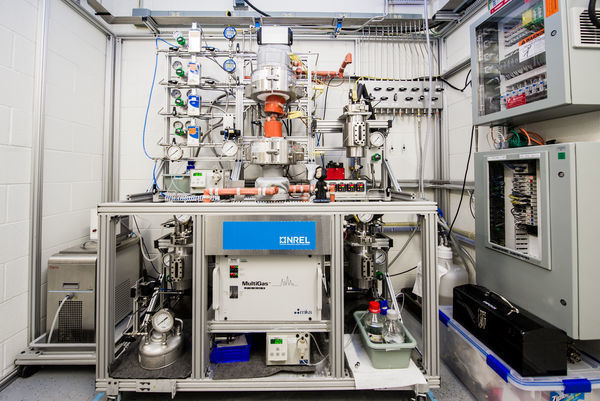
Bio-based Compound Offers A Greener Carbon Fiber Alternative
"Stampede1 helps researchers elucidate the chemistry of renewable acrylonitrile production From cars and bicycles to airplanes and space shuttles, manufacturers around the world are trying to make these vehicles lighter, which helps lower fuel use and lessen the environmental footprint. One way that cars, bicycles, airplanes and other modes of transportation have become lighter over the last several decades is by using carbon fiber composites. Carbon fiber is five-times stronger than steel, twice as stiff, and substantially lighter, making it the ideal manufacturing material for many parts. But with the industry relying on petroleum products to make carbon fiber today, could we instead use renewable sources? In the December 2017 issue of Science, Gregg Beckham, a group leader at the National Renewable Energy Laboratory (NREL), and an interdisciplinary team reported the results of experimental and computational investigations on the conversion of lignocellulosic biomass into a bio-based chemical called acrylonitrile, the key precursor to manufacturing carbon fiber. Acrlyonitrile is a large commodity chemical, and it's made today through a complex petroleum-based process at the industrial scale." [...]

Researchers implement 3-qubit Grover search on a quantum computer
"Searching large, unordered databases for a desired item is a time-consuming task for classical computers, but quantum computers are expected to perform these searches much more quickly. Previous research has shown that Grover's search algorithm, proposed in 1996, is an optimal quantum search algorithm, meaning no other quantum algorithm can search faster. However, implementing Grover's algorithm on a quantum system has been challenging. Now in a new study, researchers have implemented Grover's algorithm with trapped atomic ions. The algorithm uses three qubits, which corresponds to a database of 8 (23) items. When used to search the database for one or two items, the Grover algorithm's success probabilities were—as expected—significantly higher than the best theoretical success probabilities for classical computers." [...]

Superconducting Tokamaks Are Standing Tall
"The Science A persistent problem has dogged the largest fusion device in South Korea. The Korean Superconducting Tokamak Advanced Research (KSTAR) device has run successfully since 2008. However, controlling the vertical position of the ultra-hot plasma has proven difficult. Stable control of the vertical position allows precise shaping and positioning of the plasma boundary, vital to a reactor’s performance. Now, a team led by Princeton Plasma Physics Laboratory has sharply improved the ability to control the vertical position. The result?" [...]
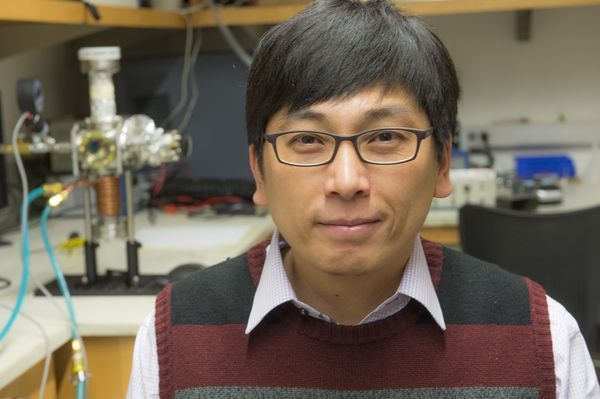
Quantum systems work together for change, UChicago scientists find
"Physicists observe particles acting coherently as they undergo phase transitions The common link between liquid-crystal TVs and the birth of the universe, when you look at the big picture, is that they are both characterized by the intriguing phenomenon in which matter abruptly changes states. Scientists want to better understand and control the behavior of particles at the exact moment that these so-called phase transitions—a change in energy in a system, much like process in which water evaporates or turns to ice—occur. A study published Dec. 18 in Nature Physics by University of Chicago scientists observed how particles behave as the change takes place in minute detail. In addition to shedding light on the fundamental rules that govern the universe, understanding such transitions could help design more useful technologies. One of the questions was whether, as particles prepare to transition between quantum states, they can act as one coherent group that “knows” the states of the others, or whether different particles only act independently of one another, or incoherently. Cheng Chin, professor in the Department of Physics, and his team looked at an experimental setup of tens of thousands of atoms cooled down to near absolute zero." [...]
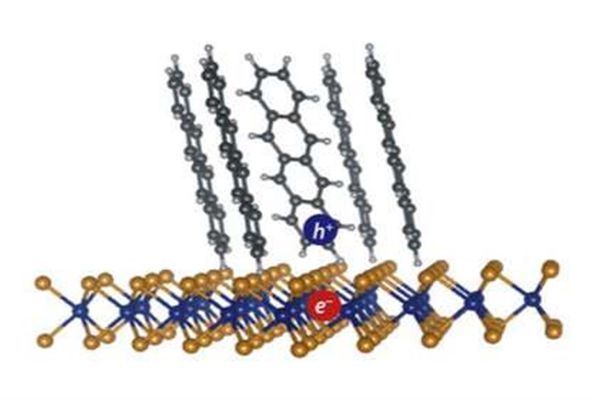
Fast-moving electrons create current in organic solar cells
"Researchers at Purdue University have identified the mechanism that allows organic solar cells to create a charge, solving a longstanding puzzle in physics, according to a paper published Friday (Jan. 12) in the journal Science Advances. Organic solar cells are built with soft molecules, while inorganic solar cells, often silicon-based, are built with more rigid materials. Silicon cells currently dominate the industry, but they’re expensive and stiff, while organic cells have the potential to be light, flexible and cheap. The drawback is that creating an electric current in organic cells is much more difficult. To create an electrical current, two particles, one with a negative charge (electron) and one with a positive charge (electron-hole), must separate despite being bound tightly together. These two particles, which together form an exciton, usually require a manmade interface to separate them." [...]
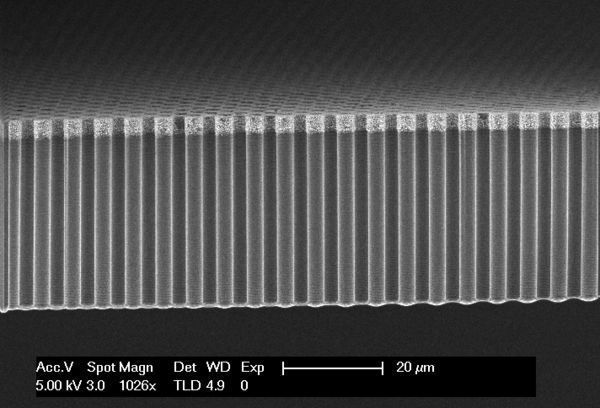
UT boosts efficiency of solar fuels using microwires
"Researchers at the University of Twente’s MESA+ research institute have made significant efficiency improvements to the technology used to generate solar fuels. This involves the direct conversion of energy from sunlight into a usable fuel (in this case, hydrogen). Using only earth-abundant materials, they developed the most efficient conversion method to date. The trick was to decouple the site where sunlight is captured from the site where the conversion reaction takes place. This study was published today in the journal Nature Energy. Researchers around the world are working on the development of solar fuel technology." [...]
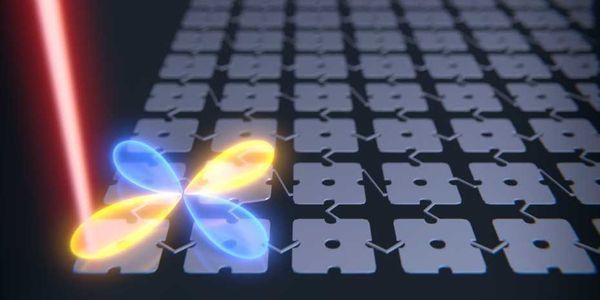
Quantum physics turned into tangible reality
"ETH physicists have developed a silicon wafer that behaves like a topological insulator when stimulated using ultrasound. They have thereby succeeded in turning an abstract theoretical concept into a macroscopic product. The usual procedure goes like this: you have a complex physical system and attempt to explain its behaviour through as simple a model as possible. Sebastian Huber, Assistant Professor at the Institute for Theoretical Physics, has shown that this procedure also works in reverse: he develops macroscopic systems that exhibit exactly the same properties predicted by theory, but which have not yet been observed at this level. He succeeded in creating an illustrative example two and a half years ago. Together with his team, he built a mechanical device made of 270 pendulums connected by springs in such a way that the installation behaves like a topological insulator." [...]
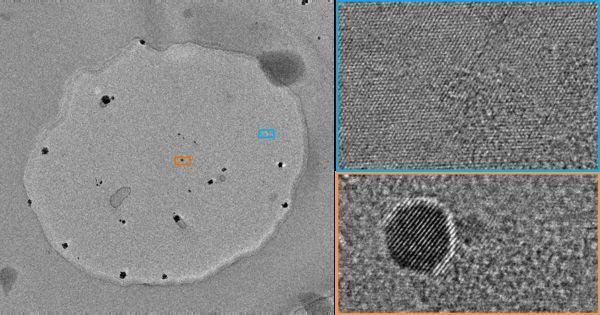
Researchers measure single atoms in a graphene 'petri-dish'
"Researchers working at The University of Manchester have shown new possibilities for observing nanomaterials in liquids by creating a graphene ‘petri-dish’. New 2-dimensional nanomaterials have the potential to improve efficiencies, reduce costs and provide enhanced performance in a broad range of applications including; better design of nanomaterials for batteries or understanding the degradation of battery materials in order to improve their performance. The unique properties exhibited by 2D materials could also lead to functional and antibacterial coatings, bioanalysis, and targeted drug delivery. However, the difficulty of controlling growth and degradation at the atomic scale is currently a hurdle to fully exploiting the potential of these exciting materials. Scanning / transmission electron microscopy (S/TEM) is one of only few techniques that allows imaging and analysis of individual atoms. However, the S/TEM instrument requires a high vacuum to protect the electron source and to prevent electron scattering from molecular interactions." [...]

Picking winners from millions of possibilities
"A clever simulation scheme helps identify the most promising compositions of two-dimensional materials A high-throughput scan of possible compositions for a new class of materials known as MXenes gives researchers invaluable direction for picking the best candidate from the millions of possible material recipes1. The simulation study by researchers from the A*STAR Institute of High Performance Computing is a significant advancement in the field of MXenes, which have exciting potential in next-generation energy storage applications. Two-dimensional (2D) materials are a relatively new class of materials that display a wide range of unusual properties associated with their ability to constrain the movement of electrons and energy in a 2D plane. The MXene alloys are a very recently discovered class of 2D materials, which could conceivably consist of any of millions of possible arrangements of transition metals (like molybdenum or titanium), carbon and nitrogen. These characteristics are reflected in the name 'MXene' — the ‘M’ represents metal atoms, the ‘X’ denotes carbon and nitrogen, while the ‘ene’ suffix signals the materials' 2D atomic structure. “Since MXenes are new, there’s still much to be learned about their structure and properties,” says Teck Leong Tan from A*STAR." [...]

Building Molecular Wires, One Atom at a Time
"Electronic devices are getting smaller and smaller. Early computers filled entire rooms. Today you can hold one in the palm of your hand. Now the field of molecular electronics is taking miniaturization to the next level. Researchers are creating electronic components so tiny they can’t be seen with the naked eye. Molecular electronics is a branch of nanotechnology that uses single molecules, or nanoscale collections of molecules, as electronic components." [...]

Artificial intelligence breaks the code to true love
"The Danish TV channel DR3’s programme ‘The Love Code' uses a self-learning algorithm developed at DTU to help singles find their soulmate. Right from old-fashioned matchmaking to modern dating services, romantic matchmakers have focused on what singles themselves desired when they assisted them in the hunt for their soulmate. In other words, there has been nothing decisively new under the sun for several hundred years. But there is now. At the request of DR3, researchers at DTU Compute have developed a self-learning algorithm and sent it in search of the recipe for a good relationship. Based on very large quantities of data about 1,334 people in well-functioning relationships, the algorithm analyses the prerequisites for a good relationship: “The algorithm receives a huge amount of information about each individual person in each of the 667 relationships, for example about food and transport habits, childhood town, height, number of brothers and sisters, pets, consumption patterns, and much more—including things that are not normally regarded as relevant to our choice of partner." [...]

Smart buildings that can manage our electricity needs
"Researchers at EPFL have developed a system that can be installed in a building to collect data on people’s energy usage. The aim is then to send this data directly to a smart electric grid that will allocate resources optimally. A smart grid that decides how best to distribute energy based on availability, cost and customers’ needs – that’s the energy concept being developed by researchers in the School of Engineering's Electronics Laboratory. They have designed a system capable of collecting data on people’s energy usage and comfort within buildings. By gathering data sent from connected devices – like smartphones and the sensors in electronic appliances – the system can obtain an overall picture of a building’s electricity needs over time and by room. This data can then be passed on to a smart grid in order to anticipate energy needs and decide how best to allocate available resources." [...]
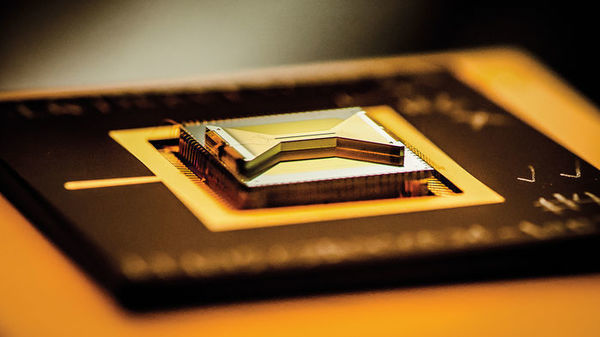
After years of avoidance, Department of Energy joins quest to develop quantum computers
"The U.S. Department of Energy (DOE) is joining the quest to develop quantum computers, devices that would exploit quantum mechanics to crack problems that overwhelm conventional computers. The initiative comes as Google and other companies race to build a quantum computer that can demonstrate “quantum supremacy” by beating classical computers on a test problem. But reaching that milestone will not mean practical uses are at hand, and the new $40 million DOE effort is intended to spur the development of useful quantum computing algorithms for its work in chemistry, materials science, nuclear physics, and particle physics. “We are looking for algorithms that can advance the science,” says Stephen Binkley, acting director of DOE’s $5.4 billion Office of Science in Washington, D.C., who in a 29 November 2017 open letter urged researchers to submit proposals for such work. The U.S. government already spends about $250 million per year on quantum computing, mostly through the Army Research Office, says Christopher Monroe, a physicist at the University of Maryland in College Park and co-founder of the quantum computing startup IonQ. But the DOE money will go mostly to its national laboratories." [...]
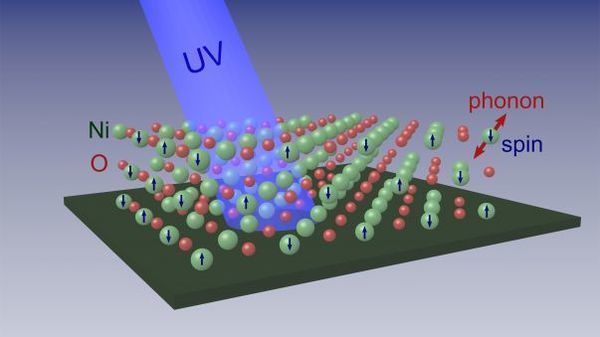
Mysteries of Nickel Oxide - a Promising Spintronic Material - Are Revealed
"UC Riverside team determines how electron spins interact with crystal lattice in nickel oxide Researchers at UC Riverside used an unconventional approach to determine the strength of the electron spin interactions with the optical phonons in antiferromagnetic nickel oxide (NiO) crystals. NiO is a promising material for spintronic devices, where signals are transmitted not by electrical currents but rather by spin waves, consisting of propagating disturbances in the ordering of magnetic materials, in a domino-like fashion. The interdisciplinary team of researchers, led by Alexander Balandin, distinguished professor of electrical and computer engineering, used ultraviolet Raman spectroscopy to investigate how spin ordering affects the energies of phonons in these materials. Phonons are quanta of vibrations of ions, which constitute the crystal lattice of materials. Phonons can interact with electrons and their spins, leading to energy dissipation. Practical applications of spintronic devices in information processing require accurate knowledge of the strength of the electron spin interaction with phonons." [...]
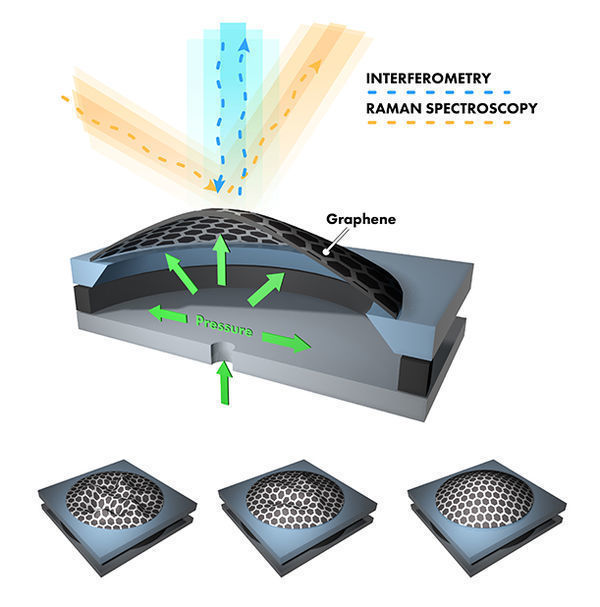
Graphene Flexes Its Muscle
"Crumpling reduces rigidity in an otherwise stiff material, making it less prone to catastrophic failure. The Science Gas pressure was applied to a crumpled graphene membrane to cause it to bulge and stiffen. The result? The gas pressure revealed that this atomically thin carbon material—universally assumed to be strong and stiff—has a “softer side.” The greater than expected reduction of rigidity with increased crumpling caused researchers to refine their understanding of the material’s mechanics. The Impact The finding of soft mechanics in a hard material gives engineers a “knob” for tuning properties. That is, changing graphene’s shape, or degree of crumpling, changes its stiffness." [...]

UChicago scientists use gyroscopes to find unusual state of matter
"You don’t have to be perfectly organized to pull off a wave, according to University of Chicago scientists. Using a set of gyroscopes linked together, physicists explored the behavior of a material whose structure is arranged randomly, instead of an orderly lattice. They found they could set off one-way ripples around the edges, much like spectators in a sports arena—a “topological wave,” characteristic of a particularly unusual state of matter. Published Jan. 15 in Nature Physics, the discovery offers new insight into the physics of collective motion and could one day have implications for electronics, optics or other technologies. The team, led by Assoc. Prof. William Irvine, used gyroscopes—the top-like toys you played with as a kid—as a model system to explore physics." [...]
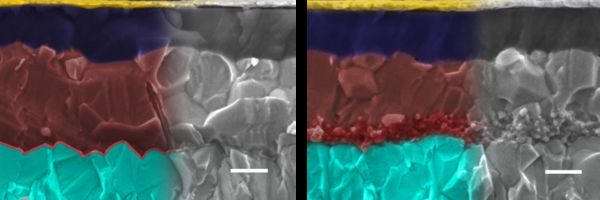
Perovskite solar cells: mesoporous interface mitigates the impact of defects
"The nominal cell operating life of perovskite solar cells is strongly influenced by their inner architecture.This was shown by two scientists at the Helmholtz-Zentrum Berlin and the Technical University of Munich. They combined experiments with numerical simulations in order to explain this observation. In only a few years, efficiencies of perovskite solar cells have been raised from 3 per cent to more than 20 per cent. What is more, the material is inexpensive and easy to process, promising a great future for photovoltaics. Unfortunately, there are still some issues, for instance with their nominal operating life: Conversion efficiencies decrease sharply when the material is exposed to UV radiation and electric field, as is the case in real operating conditions. Now, Dr. Antonio Abate, head of a Helmholtz Young Investigators Group at HZB and Prof. Allessio Gagliardi, TU Munich, have published new results on the influence of the architecture of perovskite cells on their nominal operating life in the Journal ACS Energy Letters." [...]

Neural networks take on quantum entanglement
"Machine learning, the field that’s driving a revolution in artificial intelligence, has cemented its role in modern technology. Its tools and techniques have led to rapid improvements in everything from self-driving cars and speech recognition to the digital mastery of an ancient board game. Now, physicists are beginning to use machine learning tools to tackle a different kind of problem, one at the heart of quantum physics. In a paper published recently in Physical Review X, researchers from JQI and the Condensed Matter Theory Center (CMTC) at the University of Maryland showed that certain neural networks—abstract webs that pass information from node to node like neurons in the brain—can succinctly describe wide swathes of quantum systems (link is external). Dongling Deng, a JQI Postdoctoral Fellow who is a member of CMTC and the paper’s first author, says that researchers who use computers to study quantum systems might benefit from the simple descriptions that neural networks provide. “If we want to numerically tackle some quantum problem,” Deng says, “we first need to find an efficient representation.” On paper and, more importantly, on computers, physicists have many ways of representing quantum systems." [...]

Quantum physics provides new knowledge about the brain
"A new major research project between quantum physicists and neurophysiologists will increase our understanding of the brain. In the past couple of years, quantum physicists have developed new measuring technologies which, by measuring fields rather than electronically, make it possible to quickly get far more precise and higher resolution images of the brain than before. In a new project, a team of leading quantum physicists and researchers with an insight into imaging using, for example, MRI scanning, will for the first time test and develop the new technology on biological and neurophysiological material. The aim is to create extremely high-resolution images of the brain and with very high degree of sensitivity. “The human brain is an incredibly complex system, whose function we still do not fully understand. One of today’s biggest challenges therefore is to achieve a more in-depth understanding of the brain and its underlying principles,” explains Professor Ulrik Lund Andersen, DTU Physics, who is heading the new project." [...]

Building Blocks to Create Metamaterials
"Engineers at Caltech and ETH Zürich in Switzerland have created a method to systematically design metamaterials using principles of quantum mechanics. Their work could pave the way for wider use of metamaterials in more mainstream applications by creating a purpose-driven framework for their design. Metamaterials are engineered materials that exploit the geometry of their internal structure to manipulate incoming waves. For example, a metamaterial that manipulates electromagnetic waves might bend light in an unusual way to create a cloaking device. Meanwhile, a wafer-thin acoustic metamaterial might reflect incoming sound waves to soundproof a room. This ability to control waves derives from how the material is structured, often on a microscopic scale." [...]
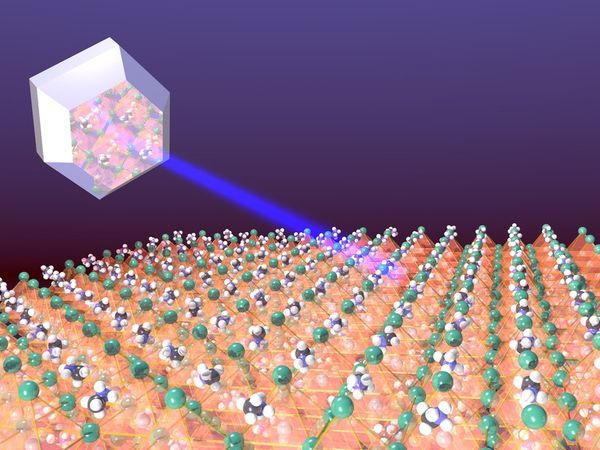
Slow 'hot electrons' could improve solar cell efficiency
"Photons with energy higher than the 'band gap' of the semiconductor absorbing them give rise to what are known as hot electrons. The extra energy in respect to the band gap is lost very fast, as it is converted into heat so it does not contribute to the voltage. University of Groningen Professor of Photophysics and Optoelectronics Maria Antonietta Loi has now found a material in which these hot electrons retain their high energy levels for much longer. This might make it possible to use more of their energy to obtain a higher voltage. Her results were published on 16 January in Nature Communications. The efficiency of solar panels is hampered by a Goldilocks problem: photons need to have just the right amount of energy to be converted into free electrons, which contribute to the voltage." [...]
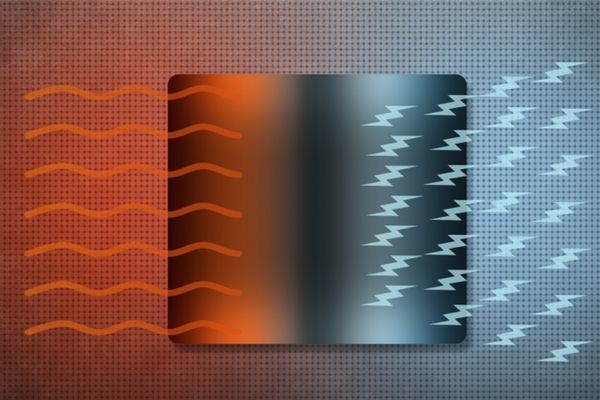
Turning heat into electricity
"What if you could run your air conditioner not on conventional electricity, but on the sun’s heat during a warm summer’s day? With advancements in thermoelectric technology, this sustainable solution might one day become a reality. Thermoelectric devices are made from materials that can convert a temperature difference into electricity, without requiring any moving parts — a quality that makes thermoelectrics a potentially appealing source of electricity. The phenomenon is reversible: If electricity is applied to a thermoelectric device, it can produce a temperature difference. Today, thermoelectric devices are used for relatively low-power applications, such as powering small sensors along oil pipelines, backing up batteries on space probes, and cooling minifridges. But scientists are hoping to design more powerful thermoelectric devices that will harvest heat — produced as a byproduct of industrial processes and combustion engines — and turn that otherwise wasted heat into electricity." [...]
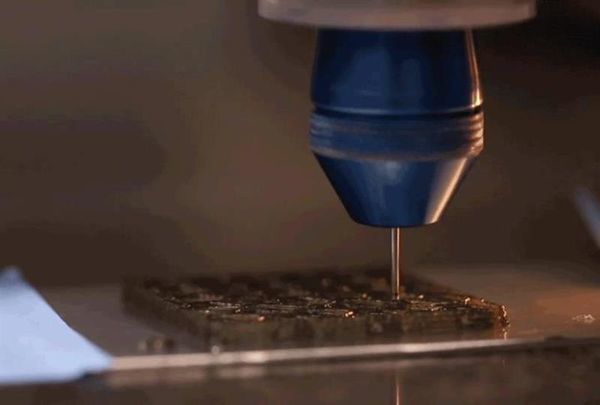
Novel 3D printing technique yields high-performance composites
"Nature has produced exquisite composite materials—wood, bone, teeth, and shells, for example—that combine light weight and density with desirable mechanical properties such as stiffness, strength and damage tolerance. Since ancient civilizations first combined straw and mud to form bricks, people have fabricated engineered composites of increasing performance and complexity. But reproducing the exceptional mechanical properties and complex microstructures found in nature has been challenging. Now, a team of researchers at the Harvard John A. Paulson School of Engineering and Applied Sciences (SEAS) has demonstrated a novel 3D printing method that yields unprecedented control of the arrangement of short fibers embedded in polymer matrices. They used this additive manufacturing technique to program fiber orientation within epoxy composites in specified locations, enabling the creation of structural materials that are optimized for strength, stiffness, and damage tolerance. Their method, referred to as “rotational 3D printing,” could have broad ranging applications." [...]
Documentação
A documentação é parte essencial do processo de aprendizagem e a Internet além de artigos interessantes de explorar também tem alguma documentação em formato PDF interessante de ler. Todos os links aqui apresentados são para conteúdo disponibilizado livremente pelo editor do livro.

GNU/Linux Command-Line Tools Summary
"This document is an attempt to provide a summary of useful command−line tools available to a GNU/Linux based operating system, the tools listed are designed to benefit the majority of users and have being chosen at the authors discretion. This document is not a comprehensive list of every existent tool available to a GNU/Linux based system, nor does it have in−depth explanations of how things work. It is a summary which can be used to learn about and how to use many of the tools available to a GNU/Linux based operating system. " [...]
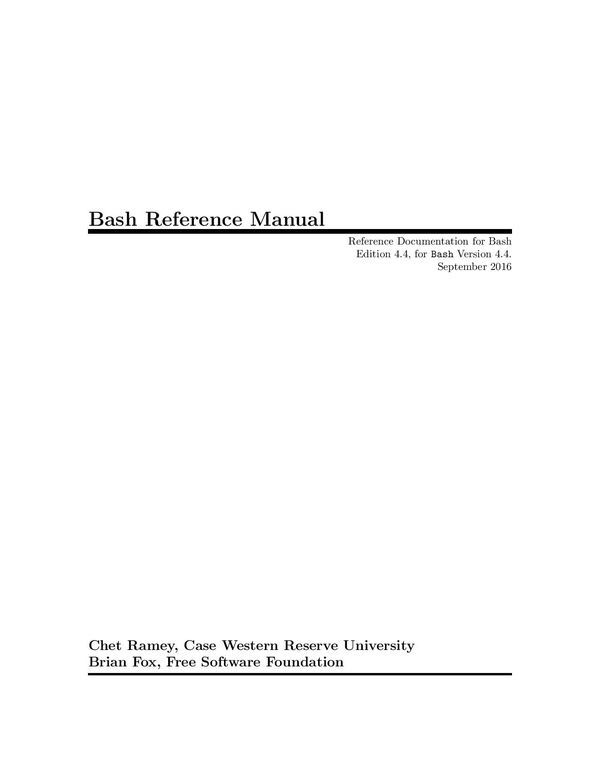
Bash Reference Manual - Reference Documentation for Bash 4.4
"This text is a brief description of the features that are present in the Bash shell (version 4.4, 7 September 2016). Bash is the shell, or command language interpreter, for the gnu operating system. The name is an acronym for the ‘Bourne-Again SHell’, a pun on Stephen Bourne, the author of the direct ancestor of the current Unix shell sh, which appeared in the Seventh Edition Bell Labs Research version of Unix. Bash is largely compatible with sh and incorporates useful features from the Korn shell ksh and the C shell csh. It is intended to be a conformant implementation of the ieee posix Shell and Tools portion of the ieee posix specification (ieee Standard 1003.1). It offers functional improvements over sh for both interactive and programming use." [...]
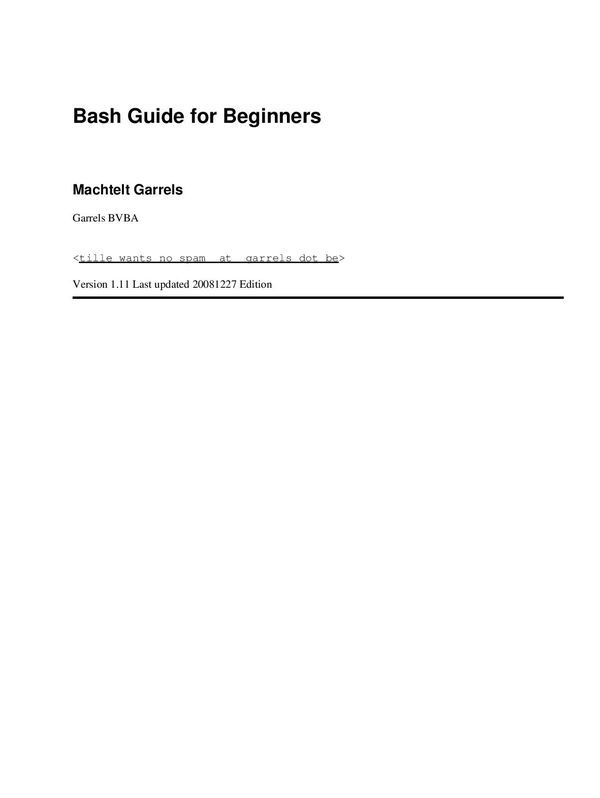
Bash Guide for Beginners
"The primary reason for writing this document is that a lot of readers feel the existing HOWTO to be too short and incomplete, while the Bash Scripting guide is too much of a reference work. There is nothing in between these two extremes. I also wrote this guide on the general principal that not enough free basic courses are available, though they should be. This is a practical guide which, while not always being too serious, tries to give real-life instead of theoretical examples. I partly wrote it because I don't get excited with stripped down and over-simplified examples written by people who know what they are talking about, showing some really cool Bash feature so much out of its context that you cannot ever use it in practical circumstances. You can read that sort of stuff after finishing this book, which contains exercises and examples that will help you survive in the real world." [...]

Advanced Bash-Scripting Guide
"This tutorial assumes no previous knowledge of scripting or programming, yet progresses rapidly toward an intermediate/advanced level of instruction . . . all the while sneaking in little nuggets of UNIX® wisdom and lore. It serves as a textbook, a manual for self-study, and as a reference and source of knowledge on shell scripting techniques. The exercises and heavily-commented examples invite active reader participation, under the premise that the only way to really learn scripting is to write scripts." [...]
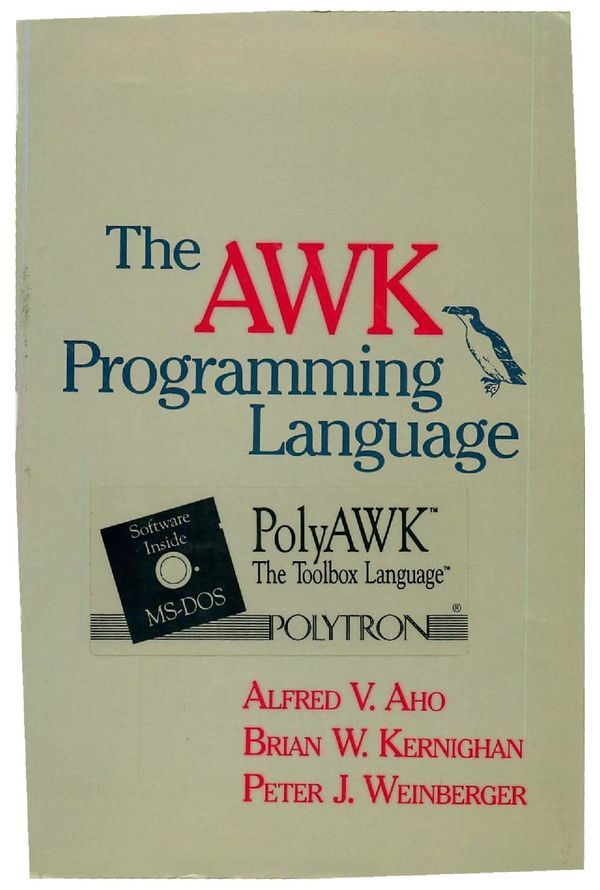
The AWK Programming Language
"Computer users spend a lot of time doing simple, mechanical data manipulation - changing the format of data, checking its validity, finding items with some property, adding up numbers, printing reports, and the like. All of these jobs ought to be mechanized, but it's a real nuisance to have to write a special purpose program in a standard language like C or Pascal each time such a task comes up. Awk is a programming language that makes it possible to handle such tasks with very short programs, often only one or two lines long. An awk program is a sequence of patterns and actions that tell what to look for in the input data and what to do when it's found. Awk searches a set of files for lines matched by any of the patterns; when a matching line is found, the corresponding action is performed. A pattern can select lines by combinations of regular expressions and comparison operations on strings, numbers, fields, variables, and array elements." [...]
Projetos Maker
Diversos Projetos interessantes.
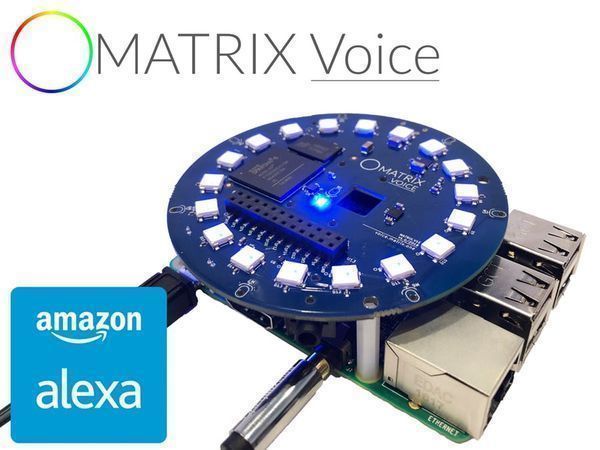
MATRIX Voice Running Alexa Demo in Hands-Free Mode
"Set up Amazon's Alexa on a Raspberry Pi with a MATRIX Voice. Use the MATRIX mic array together with a third-party wake word engine. This guide provides step-by-step instructions for setting up AVS on a Raspberry Pi with a MATRIX Voice. It demonstrates how to access and test AVS using our Java sample app (running on a Raspberry Pi), a Node.js server, and a third-party wake word engine using MATRIX mic array. You will use the Node.js server to obtain a Login with Amazon (LWA) authorization code by visiting a website using your Raspberry Pi's web browser. " [...]

PWM Regulated Fan Based on CPU Temperature for Raspberry Pi
"Many cases for Raspberry Pi come with a little 5V fan in order to help cooling the CPU. However, these fans are usually pretty noisy and many people plug it on the 3V3 pin to reduce the noise. These fans are usually rated for 200mA which is pretty high for the 3V3 regulator on the RPi. This project will teach you how to regulate the fan speed based on CPU temperature. Unlike most of tutorials covering this subject, we won't only turn on or off the fan, but will control its speed like it's done on mainstream PC, using Python. " [...]
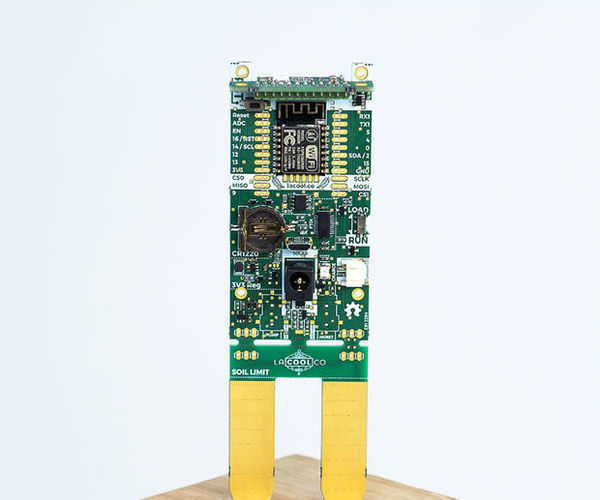
Automatically Watering System With La COOL Board
"Hello, so this time we start to dig a little deeper into La COOL Board, we want to use the Actor Output on our board to active a pump when the soil is dry. First of I want to explain how it works:La COOL Board has a 3,3 volt Output to control one actor through a transistor or a relay card. So what we want is measuring the soil moisture and activate the pump if the soil is to dry. Don't worry about the Arduino programm since there is "no" programming, only some configuration files and flashing the card. Our library is taking care of the rest so that you can concentrate on other stuff ;) Be sure you red our other instructables about La COOL Board : Getting Started Building a Outdoor Weather station The total Budget (without CoolBoard) of this instructable was 0 since I used only stuff I had laying around. If you have to buy everything it should coast less then 50.." [...]
Productivity Tracker - Powered by Raspberry Pi
"Productivity Tracker is a magic mirror, but instead of displaying the time, weather and a motivating quote, it displays 4 things; The percentage of the time you have spent on productive material on your computer and phone for that day. ( RescueTime)Your to-do list from TrelloA radar graph showing how much time you spent along with the categories of the programs-apps you used compared to yesterdays usage. (RescueTime)A weekly overview. (RescueTime)And if the percentage of the time you've spent on productive material is over 50% the LEDs will display a bright green color. If it is under 50% it will display a red color, signaling you to be more productive! You can also set a goal yourself." [...]
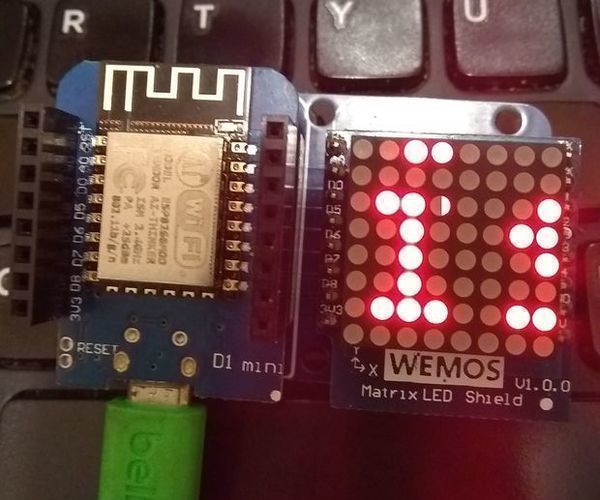
Simple Moving Message WIFI Display Using MQTT and D1 Mini
"This is a simple moving message WIFI display, We are just using 3 pieces of hardware - and can really get away with just two pieces. You will need some basic soldering skills for putting the pin headers on the D1 Mini, and shields. I generally find prices for the D1 Mini a bit better on Aliexpress, but feel free to source your own parts. Required Hardware: (Dollars are in U.S. Dollar) D1 Mini - About $2.55 https://www.aliexpress.com/item/1pcs-Smart-Electro... Matrix LED Shield - About $1.60 - https://www.aliexpress.com/item/Matrix-LED-Shield-... Not required but maybe handy to have: Dual Base Shield - About $.50 - https://www.aliexpress.com/item/Double-Socket-Dual... About $4.65 total. Some optional hardware: For power I keep it very simple, and used the USB port on the D1 - a cell phone charger, or just plugged into the USB port on a computer works well. However Wemos does have a couple of other power options, Battery Shield - About $1.10 - https://www.aliexpress.com/item/WeMos-D1-Mini-Batt... (You will need a LiPO battery which will add some cost to the project) DC power shield - About $2.11 - https://www.aliexpress.com/item/DC-Power-Shield-V1..." [...]

Raspberry Pi Zero Universal Remote
"Build a universal remote control with web interface using a Raspberry Pi, LIRC, and just a few components. I needed one because the remote in my house tends to go missing a lot. My mother-in-law's remote for her cable box broke and I don't know why she doesn't just go get the free replacement so she grabs the one in our living room and sometimes doesn't return it. Also, my kids would misplace the controller from time to time. So if I want the controller, I have to hunt down 3 people and hope one of them remembers that they took the remote. Another bonus to building the remote to control the TV, cable box, and dvd player, I realized that I can control our living room tower fan since it too has an IR remote control." [...]

Handheld Raspberry Pi Infra Red Camera
"Following the construction of my trailcam, I’ve created a new version that is also hand held. The intention is to use it as a normal trailcam as before (leaving it in position and triggering the video / light via sensor), as well as using the IR lamp & camera to view wildlife in the dark via the screen. The main construction comprises of a 12v IR lamp from a security camera along with a pi noir camera and adafruit screen all controlled by a raspberry pi (model 2B). I’ve added a couple of buttons to control the light, video record etc for use in handheld mode with the pi controlling the functions in automatic / trailcam mode. " [...]
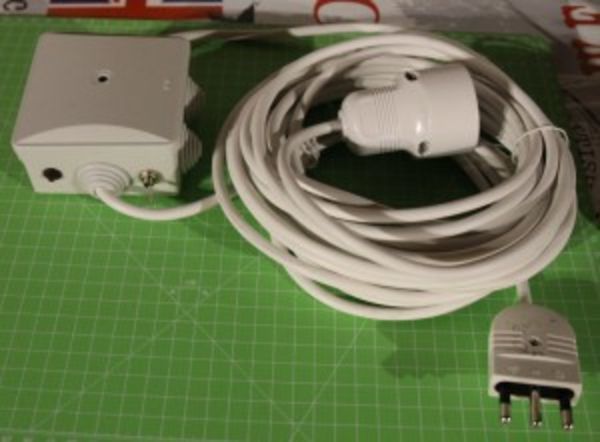
ESP32lights
"Thanks to ESP32lights you can turn a load on and off (I used it for my christmas lights) - manually - based on daily schedules - based on the light intensity ESP32lights connects to your wifi network, can be configured and operated via a web browser and it’s optimized for mobile devices (responsive web interface based on jQuery Mobile). " [...]
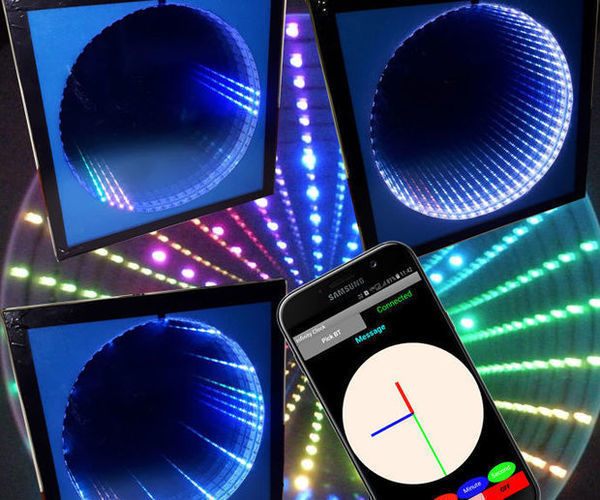
RGB Infinity Clock With Own BT App
"Normal Digital and Analog clocks are boring, So plan to develop a cool clock with custom colors for Dial, Hour hand, Minute hand and Second hand. For this first want to develop the clock using Addressable RGB LED strip. Then for communication with Arduino to Change color i plan to build a app using App inventor. All are working fine. Lets see it step by step. Note Colors are clear with eyes, while through camera it reflect the top glass color blue combined." [...]
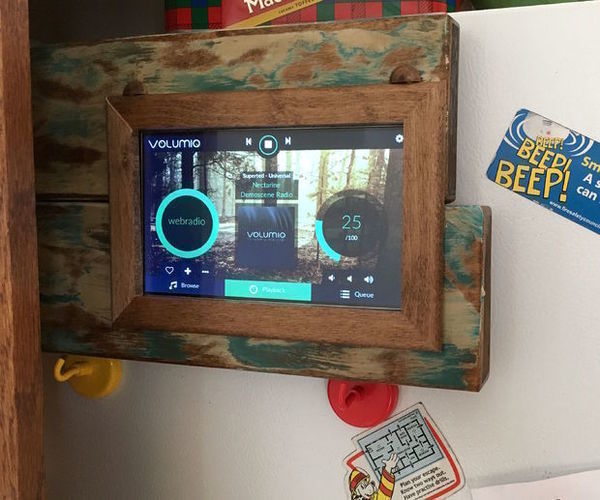
FridgePi : Leftovers Never Sounded So Good
"For years I've been Air Playing music from the iPhone to a stereo setup in the basement, with speakers wired back up into the kitchen. It works well enough, but drained my phone's battery and limited the content to my iTunes library or some web radio streams that were a bit of a pain to select and get playing. Enter, FridgePi! A Raspberry Pi powered touch screen portal to the world of internet radio and beyond! P.S.As Sparky the fridge magnet fire dog says, Don't forget to plan your fire escape and practice it with your whole family! :)" [...]
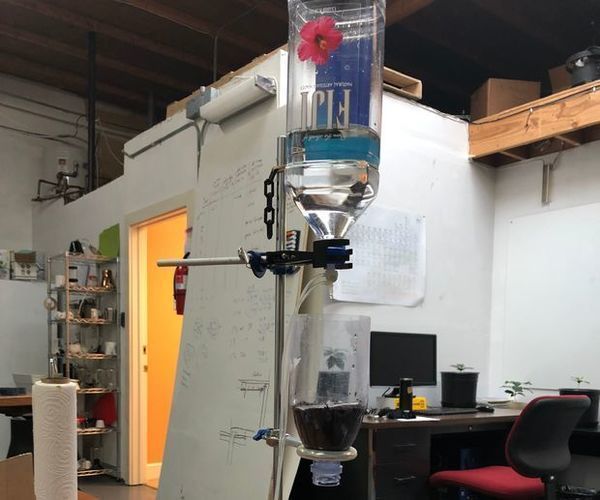
DIY Arduino Slow-Drip Cold Brew Coffee Tower
"Cold brew coffee is taking the world by storm. I love cold brew coffee. Its rich, chocolatey, low acidity and really packs a punch! Fill up a small mug with this thick elixir and splash it with some milk, and Im ready to go for the day. Cold brew coffee is brewed using cold or room temperature water. Certain acids present in coffee are not extracted at this lower temperature, leaving a smoother, sweeter cup that is a bit easier on the stomach." [...]
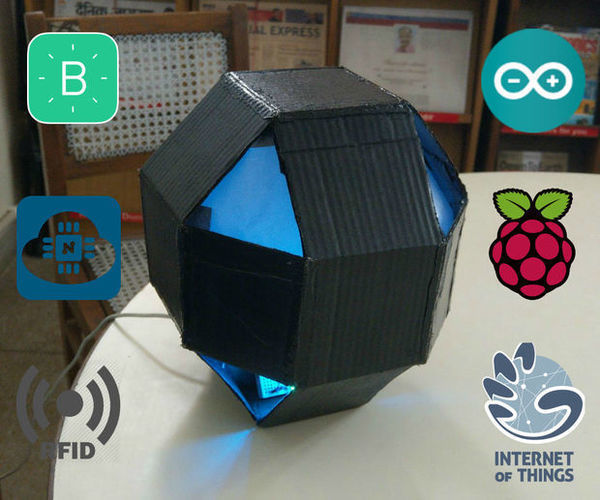
Octopod: a Smart IOT Home Automation Project
"Hello Makers, I am really thrilled to present to you Octopod: A Smart IOT Home Automation Project. There are many IOT Home Automation Projects out there, but trust me there is nothing like this! Octopod is made using NodeMCU, Arduino Uno and Raspberry Pi 3. Octopod allows you to make your Home to a Smart Home. Octopod sends you a variety of like Temperature, Humidity & Gas Quality inside your home. Octopod sends you notification whenever it detects any sort of Motion inside and tells you when you need to Water your Plants." [...]
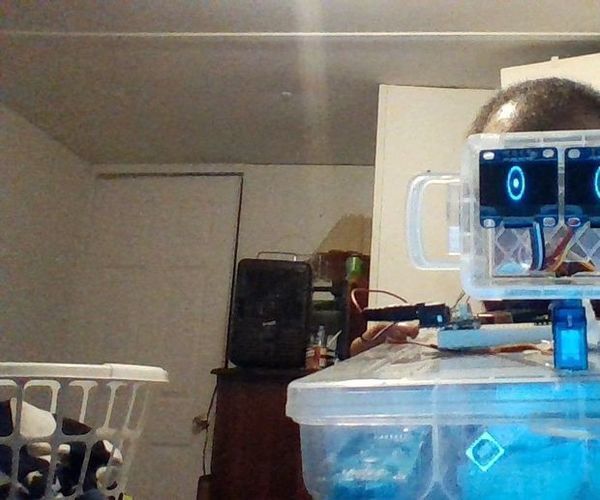
Arduino Bluetooth Robot Face
"This is a very basic design of a robot face made of 2 OLED's and a servo controlled over bluetooth from a smartphone. I am working on a robot and i wanted develop a simple start of controlling they facial features. i added the bluetooth to see the different features at the push of a button. With this instructable you will get a very basic view of a simple way to do this and a good platform to build from for your own future projects. This is my first tutorial so its probably going to suck but ask any questions you would like in the comments. Also i am fairly new to the world of electronics so if my stuff is jacked up please let me know thanks." [...]
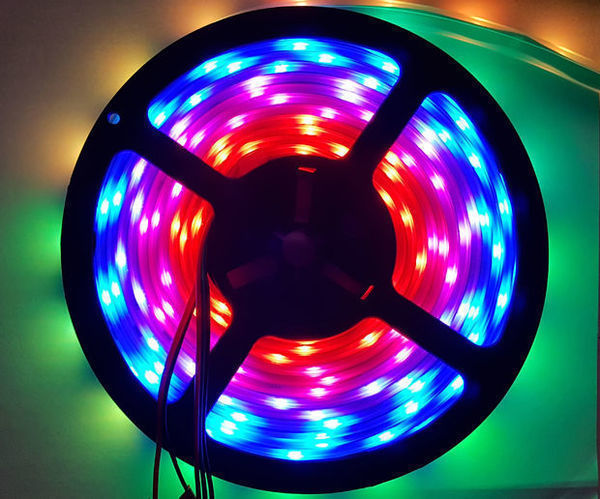
Disco-pi
"This instructable shows how to use a Raspberry Pi to control a coloured LED strip, based on music played from a web browser. It shows how to create a basic website using Node.js over HTTPS and use socket.io over WSS (Secure Websocket). The website has a single page which has a very basic layout. The webpage populates a drop down list with music files, which are located in the public/audio folder on the server. Selecting an option in the list plays the music file in the webpage using the HTML 5 audio element. While playing the music file, the webpage uses the AudioContext interface to analyse the music, which is then sent to the server over a secure websocket connection." [...]
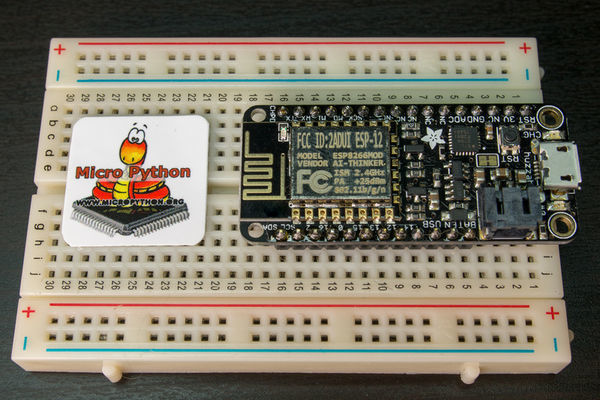
MicroPython Basics: ESP8266 WebREPL
"One unique feature of MicroPython on the ESP8266 and its WiFi microcontroller is a WebREPL (read-evaluate-print loop, like a Python 'command line') accessible through a webpage. Instead of using a serial connection to the board you can run Python code directly from your browser in a simple terminal. You don't even need to connect the board to a WiFi network, it can create its own that you use to access the WebREPL! This guide will walk through how to enable and access the WebREPL on MicroPython ESP8266. Note only the ESP8266 version of MicroPython supports the WebREPL, and be aware the WebREPL is an experimental feature that is under active development. Follow this guide to learn how to explore the WebREPL on MicroPython ESP8266 yourself!" [...]
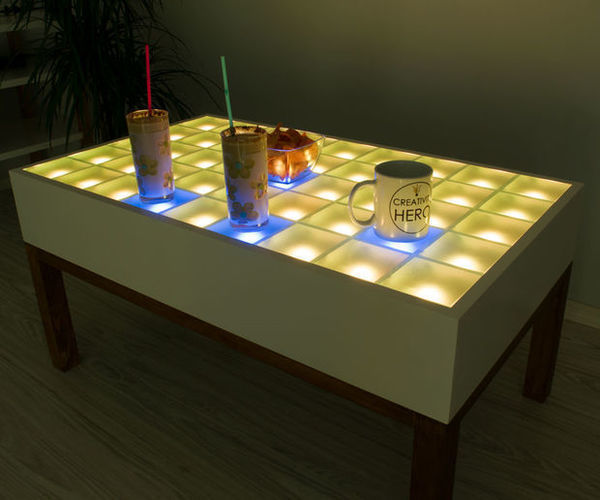
DIY Interactive LED Coffee Table
"In this Instructable Im going to show you how I made an interactive LED coffee table step by step. I decided to make a simple, yet modern design, and focused more on its features. This amazing table creates amazing ambiance in my living room. How does it work? It is actually controlled through a custom-made Android application, so you can change both the reactive and the background color using your Smartphone, and also you can control the brightness. I used an MDF for the upper part, a pine for the frame and the legs below, and a glass on the top." [...]

Remotely Shutdown or Restart a Computer With ESP8266 Device
"Just to be clear here, we are shutting down YOUR computer, not someone else's computer. The story goes like this: A friend of mine Facebook messaged me and said he has a dozen computers running a bunch of math but every morning at 3 am they lock up. Since the computers are 30-minutes away, it's a huge nuisance to drive two towns over (we live in South Dakota) to power-cycle the computers. He asked, could I build him an IoT device that would allow him to restart the offending computer from the comfort of his cozy bed? Never to miss out on a challenge, I agreed to put something together for him, this is that project. Using two bit-shift registered, an ESP8266 ESP01, a handful of LEDs, and some homemade optoisolators, the entire project costs about $5 if you buy the parts from China on Ebay." [...]

Arduino Apple Watch
"If you find this project interesting please vote for me in the Arduino contest and the Epilog challenge. I wanted a smartwatch that showed me notifications from an iPhone, was small enough to wear, and had a rechargeable battery that lasted for at least a day. I created my own Apple watch based on an Arduino. It is a smartwatch based on an Arduino mini pro, which is connected to the iPhone over Bluetooth. The USB-micro port is connected to the battery which makes the charging easy and simple. The wires on the front are touch buttons which sense if you put your finger on them, which allows you to interface with the watch." [...]
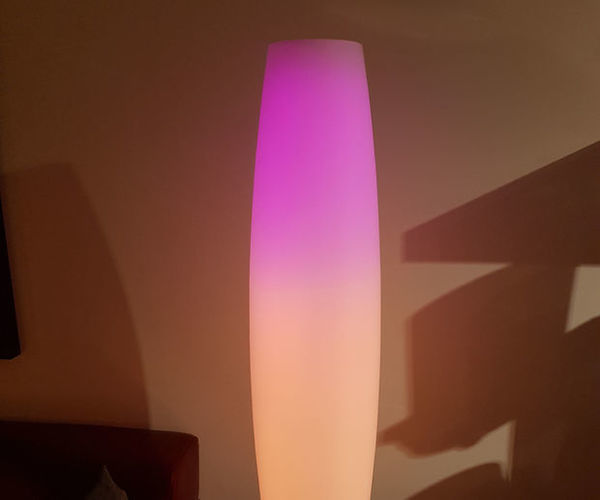
PhotonLamp - a WS2812b Equipped Designer Lamp With MQTT Control
"Several years ago we bought a designer lamp which had a lamp shade in form of a cigar and was made out of milk glas. We liked the particular design of the shade and the overall appearance of the lamp. But i've been not really satisfied with the light which came from five small standard light bulbs. Since the shade has a rather small radius, you got no continuous light impression but you could see the single bulbs through the shade. When i stumbled across a WS2812b LED stripe an idea was borne: I wanted to convert/upcycle the lamp and replace the standard light bulbs by RGB LEDs. Not to mention that the "new" lamp should be controllable by Wifi to get a higher WAF 8-)." [...]
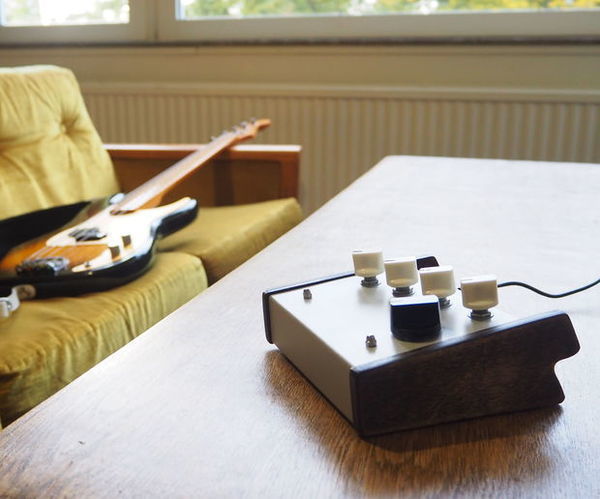
ANDI - Random Rhythm Generator - Electronics
"ANDI is a machine that generates a random rhythm at the push of a button. Each beat is unique and can be tweaked with five knobs. ANDI is the result of a university project that was about inspiring musicians and examining new ways to work with drum beats. More information about the project can be found at andinstruments.com During the design phase of ANDI a lot of inspiration was taken from the maker community and especially from exciting projects here at Instructables. To return the favor I have written this Instructable on how to design the electrical circuit for the ANDI beat generator. It is a simple circuit with five rotary knobs that controls the playback of short drum sounds stored on a micro-SD card via an Arduino Nano." [...]

DIY Arduino Nano Shield
"Hello Guys!! This DIY is for making an expansion of your Arduino Nano using a couple of tools and instruments present at your worktable and at a very few couple of dollars.This DIY came to my mind while I was working upon some project and has to use a breadboard for using extra pins and the breadboard acquired a large space.. This can be used on various projects and you will also not need any modifications while using it.." [...]

Automated LED Lighting for Planted Aquarium Using RTC
"A couple of years ago I decided to set up a planted aquarium. I was fascinated by the beauty of those aquariums. I did everything which I was supposed to do while setting up the aquarium but neglected one most important thing. That thing was lighting. Everything looked fine for few days but then algae started growing everywhere in the tank and the plants were not doing great. It is a tough job to get everything back to normal." [...]

TIVA Based Obstacle Avoiding Robot
"Hi there guys I am back with another tutorial of the tiva instructables series. This time it is a TIVA based obstacle avoiding robot made by friends of mine as their semester project. " [...]
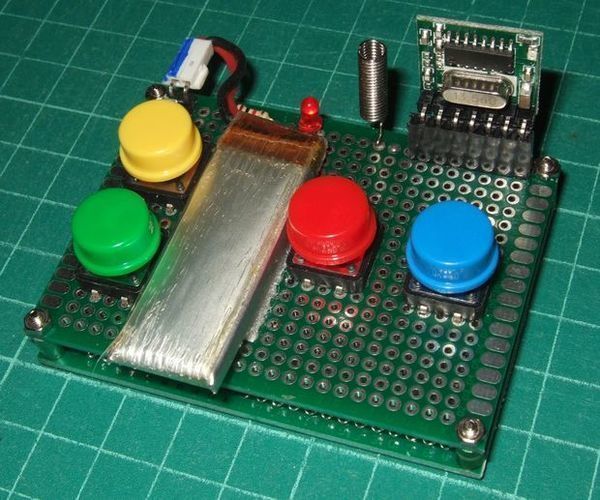
4-CH DIY 433 Mhz Module Transmitter {No Coding}
"The instruction "4-CH DIY433 MHz module Transmitter {No coding}" introduce how to build simple four channel DIY transmitter using 433 Mhz Tx module. Generally,this kind of devices in the market using for car/motorbike thief-alarm remote.We can apply them to control RC toy like cars,tracked robots,boats or even airplanes.It doesn't need any programmable controllers or coding sketch.The wireless modules are small and light,good for using to control tiny ground toys,park flyer planes or replacing old broken electronic toy remotes. " [...]

Arduino UNO + 2.4 TFT LCD Display Shield Touch Panel ILI9341
"Basic code to make Arduino communicate with ILI9341. Colorful, 18-bit 262,000 different shades4-wire resistive touchscreen8 bit digital interface, plus 4 control lines Download ILI9341 Datasheet:https://www.pdf-archive.com/2018/01/07/ili9341/ The shield connects ILI9341's data pins 0-7 to Arduino digital pins 2-8 (allowing parallel communication, not SPI). ILI's RESET goes to pin to Arduino analog pin A4.CS (chip select) to A3. RS (CD command/data) to A2. WR and RD to A1 and A0. ILI9341 is integrated inside the display." [...]
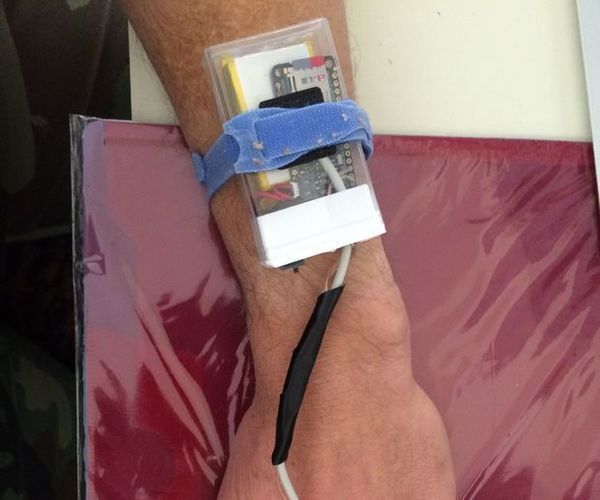
Pulse Oximeter With Much Improved Precision
"If you recently visited a doctor, chances are that your basic vital signs were examined by a nurse. Weight, height, blood pressure, as well as heart rate (HR) and oxygen saturation in peripheral blood (SpO2). Perhaps, the last two were obtained from a red-glowing electronic finger probe that displayed relevant numbers on a tiny screen in minutes. That probe is called pulse oximeter and you can find all the basic info about it here. One can easily buy a simple pulse oximeter, sure, but where is the fun in it? I have decided to build my own, first for the heck of it, but more importantly with a specific application in mind: nocturnal oximetry where both HR and SpO2 data would be continuously collected overnight and recorded on a micro SD card." [...]

Battery Powered ESP IoT
"This instructables show how to make a Battery Powered ESP IoT base on the design in my previous instructables. " [...]
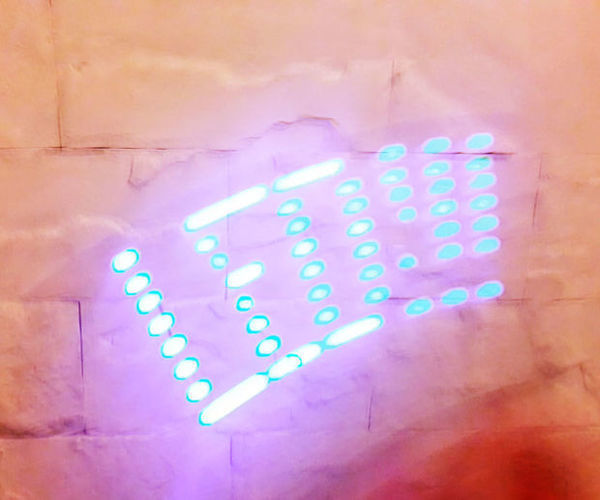
Digital Rattle
"while learning how to blink a led with Arduino (! ), i read that if the frequency is too high, you won't see the blinking anymore, although it's still there. The way to see it is to move the board very quickly, and due to persistance of vision, the eye can catch a series of dots. I found this cool and thought of using this property to display slightly more advanced patterns, like geometric shapes and letters. There are many such devices, attached to a motor, that does the job pretty well. But I wanted something very light, that you could take anywhere." [...]
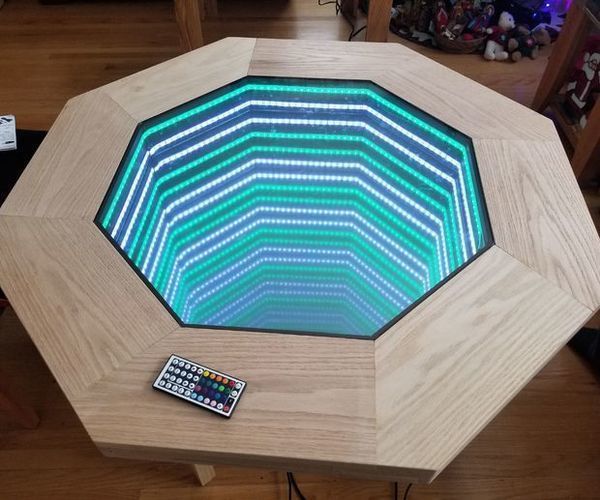
Octagonal Infinity Mirror Table
"In my house we play a lot of board games with friends, but I didnt have a great space to lay out the larger games we often used. Last year I decided to give our game area an upgrade and build a table sized for large games. Since I was designing and building my own table I wanted to make it something unique, so I decided to add an infinite mirror to the center for additional light and mood. One year later I decided to make a second table with some aesthetic upgrades. This instructable details how I put together an octagonal table with an embedded infinity mirror that uses RGB LED strips and glass I was fortunate enough to have available. The same principle and schematics can apply to other sized windows and even to other shapes." [...]

From Data to Graph. a Web Jorney With Flask and SQLite
"This Instructable is competing on contest: "Raspberry Pi". If you like it, please give your vote by clicking at the above banner. Thanks a lot! ;-)On my previous tutorial, Python WebServer With Flask and Raspberry Pi, we learned how to interact with the physical world, thru a web front-end page, built with Flask. So, the next natural step is collect data from the real world, having them available for us on a webpage. Very simple!" [...]
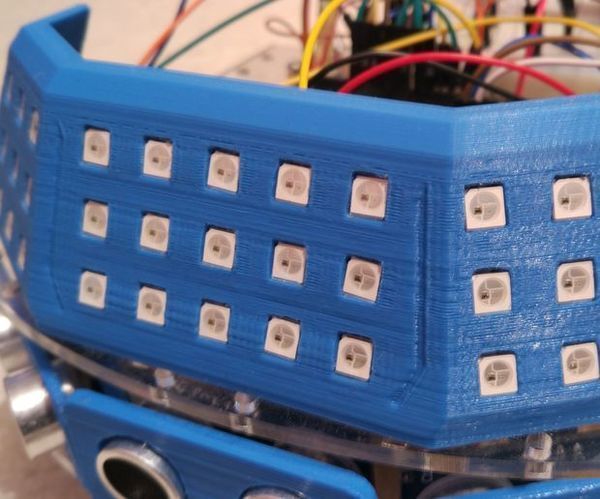
Programmable Led Bar
"What I've done is practically only holder for WS2812b leds. But it's more, it's stylish. You can mount it wherever you want and it's fully 3d printable. I've mounted it on my R/C car, but you can program it to be a weather station or it can be an extraordinary headlight. " [...]
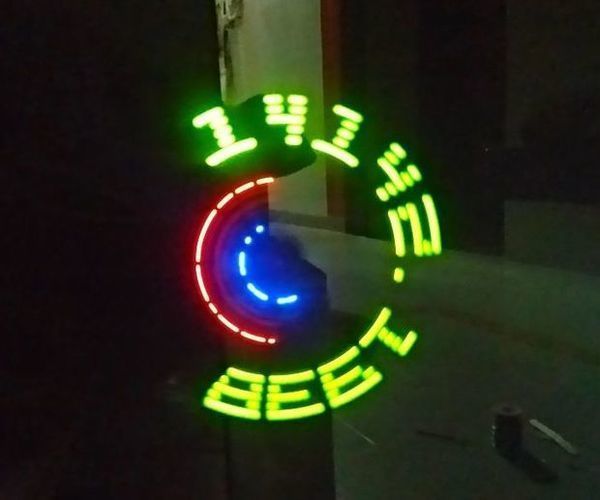
Real time bitcoin-ticker (POV)
"Crypto Currencies have grabbed huge attention in the past year due to their rapidly increasing price. And many people has invested in these crypto currencies. Therefore an idea came to my mind to make a real time btc-ticker which will update the user with the price every next minute. This will make the trading more efficient. As POV displays are attractive and can be placed anywhere on the office table or as a showpiece on the showcase. Therefore I decided to make a btc-ticker using NodeMcu and POV display" [...]

Arduino Tutorial: Adding Sensors to Your Data Logger
"This post isn’t another How-To tutorial for a specific sensor because the Arduino community has already produced a considerable number of resources like that. You’d be hard pressed to find any sensor in the DIY market that doesn’t give you a dozen cookbook recipes to follow after a simple Google search. In fact, you get so many results from “How to use SensorX with Arduino” that beginners are overwhelmed because few of those tutorials help people decide which type of sensor suits their skill level. This post attempts to put the range of different options you can use with a Cave Pearl data logger into a conceptual framework, with links to examples that illustrate the ideas in text. One thing to note before you start is that many modern sensors will only accept 3.3v inputs, so UNO based projects need to check if the sensor they want to use is 5v tolerant. Most sensors from vendors like Adafruit put regulators on their breakout boards to handle this 3.3v-5v translation, but you may have to place level shifters between some of the more advanced digital sensors and an UNO based logger." [...]
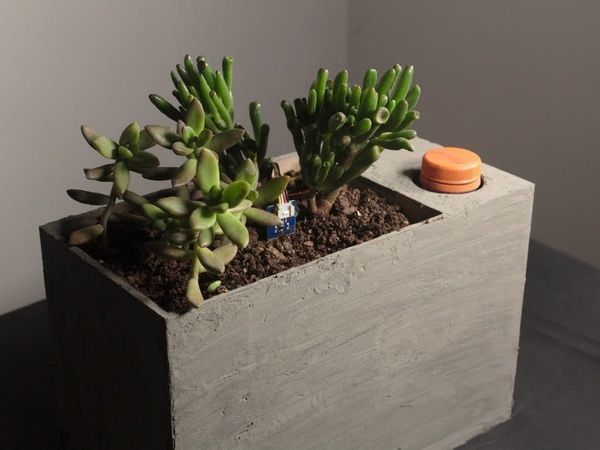
Sprout: Modern Indoor Self Watering Planter
"Sprout is a Modern Indoor Planter which automatically waters your plants, herbs, vegetables, etc and will revolutionize your gardening game. Sprout is a Modern Indoor Planter which automatically waters your plants, herbs, vegetables, etc and will revolutionize your gardening game. It consists of an integrated water reservoir from which water is pumped & keeps the plant's soil hydrated. A soil moisture sensor is calibrated such that it periodically measures the moisture of the soil thereby regulating the water flow. If the soil is too dry, the water pump automatically switches ON and goes OFF when the soil moisture has reached the desired level. If you're the person who underwaters their plants, Sprout will ensure you will never have to worry about being a bad gardener again." [...]
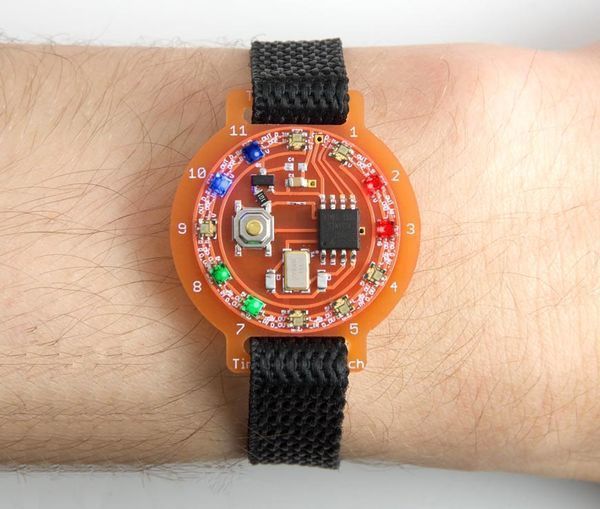
Tiny Colour Watch
"This article describes a minimalist ATtiny85-based watch using 12 APA102 RGB LEDs, arranged like a clock face, to show the time analogue-style. It shows the time to the nearest second, and the positions of the hour, minute, and second hands are displayed in blue, red, and green respectively. Intermediate times are shown by the relative brightness of two adjacent LEDs: To show the time you press the button on the watch face; the display is blanked after 15 seconds to save the battery. The ATtiny85 is clocked by a crystal, ensuring that the time is accurate to within a few seconds a month. Introduction This is the third of my LED-based watch designs. My earlier Tiny Time 2 Watch used monochrome LEDs, and distinguished between the hour and minute hands by flashing the minutes LED." [...]

Programming STM32F103 Blue Pill using USB Bootloader and PlatformIO
"This is the infamous Blue Pill board – a $2 ARM STM32F103 development board with all the capabilities of a Teensy 3.x at a fraction of the price of an Arduino. So what’s the catch? I’ll tell you – software support. A couple weeks ago I decided to invest some time learning this platform because I was sick of paying 20+ dollars for a Teensy. While the PJRC platforms are fantastic, they are expensive and need a proprietary boot loader in order to work. I want a small and powerful arm chip which I can integrate INTO my own PCBs and the Teensy does not easily or cheaply allow this." [...]

Arduino Intervalometer
"Hello and welcome, today I'm making an intervalometer for my Canon camera. The sketch gives you control over the Number of frames The time between frames The total time required and the Shutter speed, when you have put your camera into bulb mode. It will also display how long the time-lapse movie will be once compiled. " [...]

Wireless Communication Using NRF24L01 Transceiver Module for Arduino Based Projects
"This is my second instructable tutorial about the robots and micro-controllers. It is really amazing to see you robot alive and working as expected and believe me it will be more fun if you control your robot or other things wireless with fast and wide range of communication. That is why this instructable is about wireless communication. " [...]
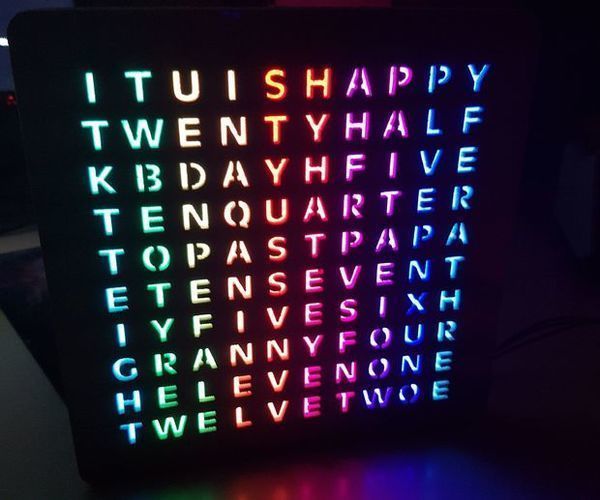
Minimalist 3D Printed RGB Word Clock
"A few months ago, I decided to make a word clock as a homemade Christmas gift for my grandparents. The main challenge I wanted to give myself was to 3D print the entire clock, except for the electronics. This instructable will follow a slightly different format, since I chose to do a lot of optional things. Although my design may differ from the clock you intend to create, the steps below will work universally for designing your own. " [...]
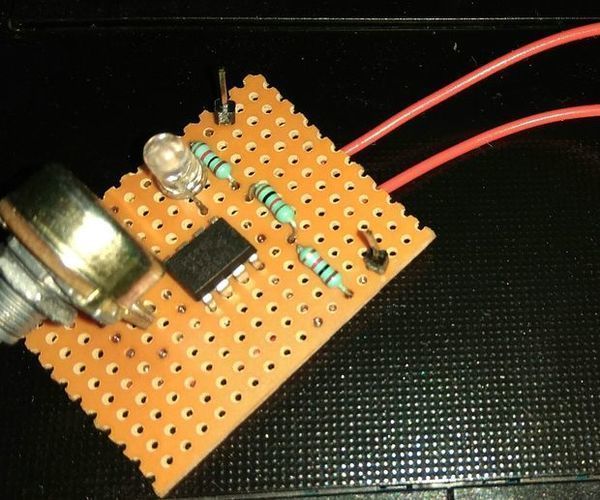
D.I.Y. Continuity Tester
"We have always used the continuity function of a multimeter to find out continuity in PCB,wires,circuit traces,fault detection,etc. When continuity is found the Buzzer inside the meter rings and when there is no continuity it does not ring. We will here make the same thing by using just a Basic Comparator and some resistors.. This will enable us to make such circuit ourselves and will also give us a practical example of working of OPAMP as Comparator,," [...]
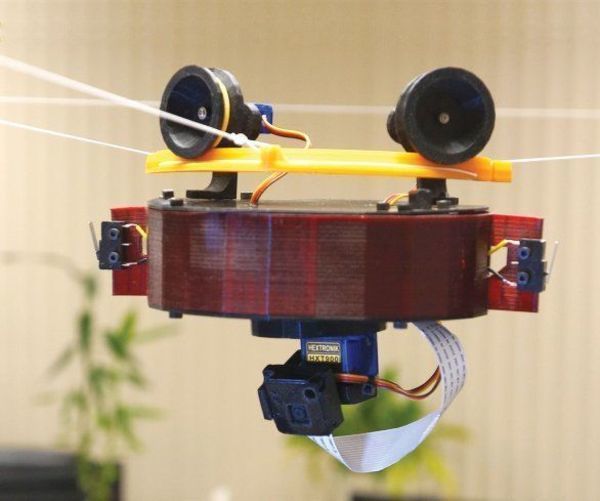
Home-Made 3d Printed Camera Drone
"Skycam is a little robot that travels on a rope or string, can turn corners, and even has a little camera with pan and tilt. The whole thing can be controlled from your phone or any browser and it even streams live video. " [...]
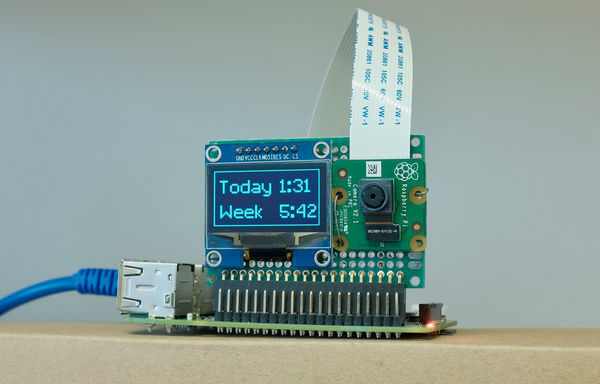
facepunch: A facial recognition punch clock
"The concept is rather simple: the picamera takes a photo every 15 seconds, if my face is found, current time is recorded. The logged time then added up to calculate my exact working hours every week. The result is displayed on an OLED screen. " [...]
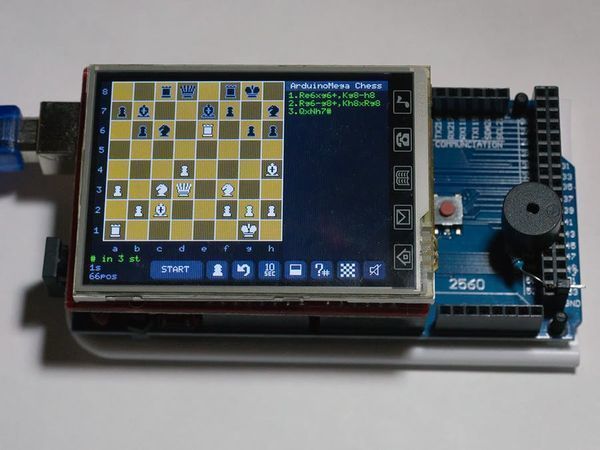
Arduino Mega Chess
"Chess processor with GUI dedicated for Arduino Mega. After some my Arduino project remains unclaimed touchscreen, so I decided to realize my chidhood dream to create a chess program. After a couple of months it wins me, but it is not big deal because i do not have any chess rating, just amateur. This project uses Arduino Mega 2560 because of lack of operative memory on Uno, 2.8 inch touchscreen, passive buzzer, and about 2000 lines of code. Program uses Negamax algorithm, iterative deepening, some kind of killer heuristic, time control. No any bitboards or hashes for obvious reasons." [...]
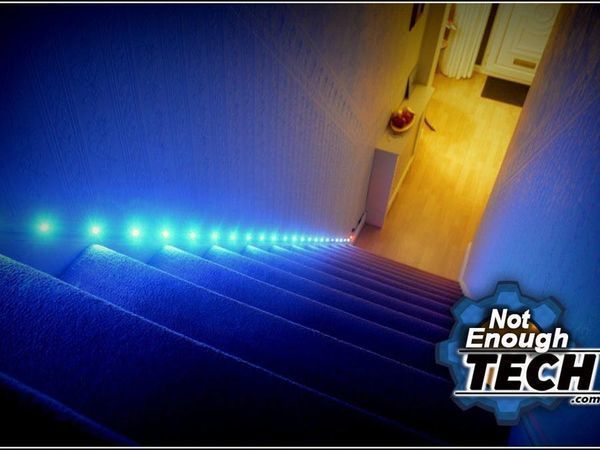
Automated Staircase RGB LED Lights
"Create an awesome looking motion activated RGB lights for any staircase under $20! My staircase has claimed a broken toe some time ago. Fortunately, it wasn’t my toe, but I feel for the poor fella. The toe is OK now, but it got me thinking, is there anything I could do to reduce the risk of dealing with another victim? Plus if I could do this on the cheap, that would be super! I created this tutorial for my personal blog (NotEnoughTech.com) where you will find more details about the build." [...]
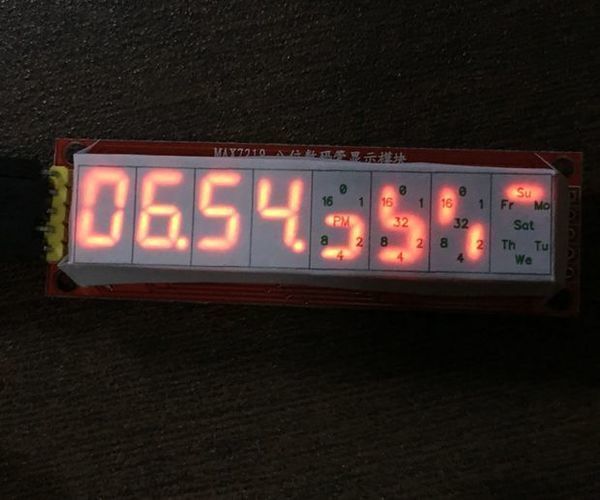
Digital & Binary Clock in 8 Digits X 7 Segments LED Display
"This is my upgraded version of a Digital & Binary Clock using an 8 Digit x 7 Segment LED Display. I like to give new features for usual devices, specially clocks, and in this case the use of 7 Seg display for Binary Clock is unconventional and it is an interesting and a different way of applying it. My choice in this project was to use a display powered by the MAX72xx wich is really useful because it uses only three digital Arduino ports. I also used an inexpensive DS1307 RTC module to store the time mode of clock on its internal memory: standard 24HS or AM-PM. Every time you reset or restart the Arduino, the time mode will change. The first four digits at left of display show the hours and minutes in decimal numbers." [...]

How to Make a Professional Looking Proximity Sensor
"In this Instructables i will show you how to make a very simple but very professional looking proximity sensor. You can watch the video which is embedded in this step for construction, parts list, circuit diagram & testing or you can continue reading the post for further details. " [...]
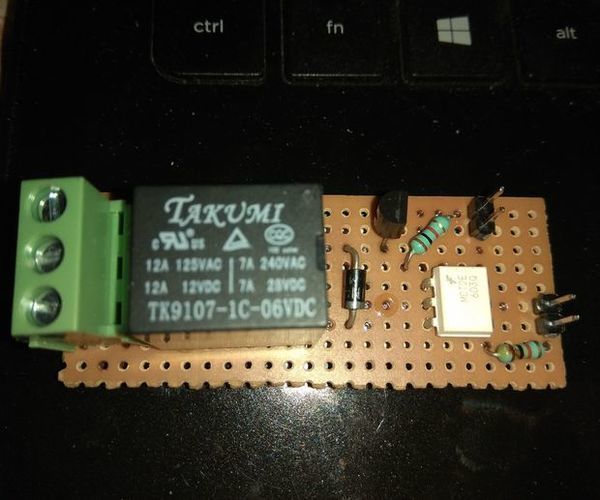
DIY Relay Board
"Relays are always used for AC switching circuits...we frequently need AC loads like Fan Bulbs to operate automatically with conditions like decreased light, increased temperature, etc.Also we come across situations like when we need to control appliances remotely using smartphone or we have sensor that detects human presence and turns on light ,fan and turns off when it is not detected..in all these applications we use a Relay board and we are now going to make such a Relay board that can be used along with logic circuits or micro-controllers to handle AC loads or High voltage DC loads.." [...]
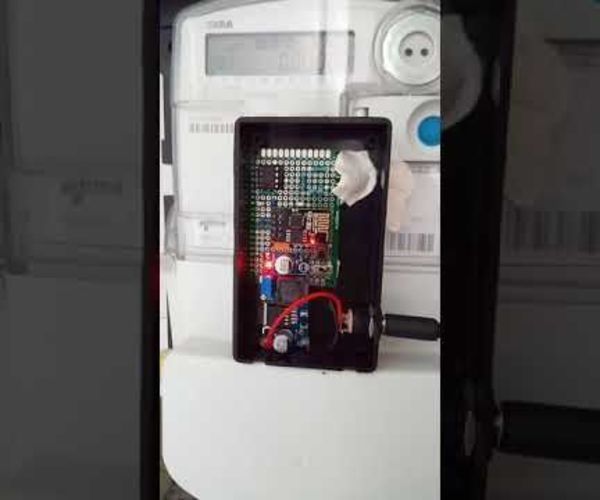
Read Your Main Power Electricity Meter (ESP8266, WiFi, MQTT and Openhab)
"In this Instructable you find out how I read my Main Electricity Power use of my house and publish it via an ESP8266, Wifi, MQTT in my Openhab Home Automation. I have a 'smart meter' ISKRA Type MT372, however it has no easy possiblility to export the data. Therefore I used the LED pulses to read the current Power, the LED pulses 1000 times for 1 kW/h. " [...]

Wireless Serial (UART) for Arduino/STM32/etc.
"Hopefully everybody will agree with me that the Arduino Serial is a great tool for debugging your projects. Well, it's basically the only option for debugging an Arduino. But sometimes, it is not possible or practical to run a USB cable from the Arduino or any other microcontroller into your computer. So I made this UART-WiFi board, based on the ESP8266-01, which is dirt cheap these days. The boards is small, you can plug it into a breadboard, connect power, RX, TX and ground and it will transmit everything it receives from the UART to you computer via WiFi and vice versa. Features: baudrates up to 115200 (theoretically even up to 921600, but this is not tested) receives/sends data from UART and sends/receives data via WiFi directly to your computer using port 23 (Telnet) 18 components, parts cost about USD 3.5020 x 45 mm dual sided PCB, breadboard compatible 5 V tolerant RX pin voltage input from 12 V to 3.3 V, current draw about 80 mA on averageI have been using these boards for about half a year now and I found them extremely useful." [...]
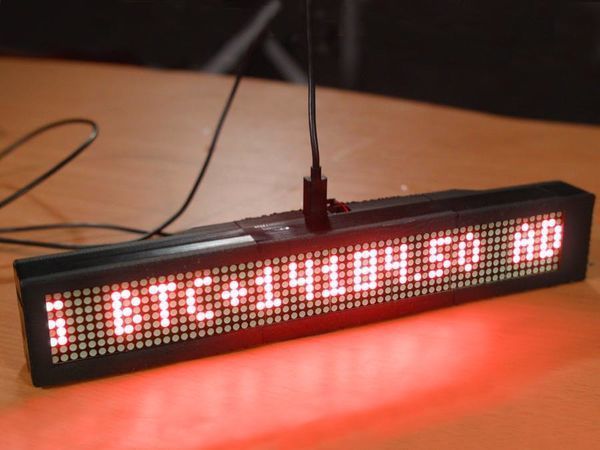
Realtime Cryptocurrency Ticker / YouTube Subscriber Counter
"Compact LED display unit that functions as cryptocurrency ticker and doubles as a realtime YouTube subscriber counter. This project was created for our 100,000 YouTube subscriber milestone. Watch the video below for an overview of the project, demonstration of what it can do, and a Q&A special at the end. Combine the LED Displays We're using two 4-in-1 Max7219 8x8 LED displays for this project. Max7219 modules can be daisy chained together to display long messages. The 4-in-1 modules come pre-soldered together, but we need to combine both displays to make one with 8 elements for space to show our cryptocurrency ticker." [...]
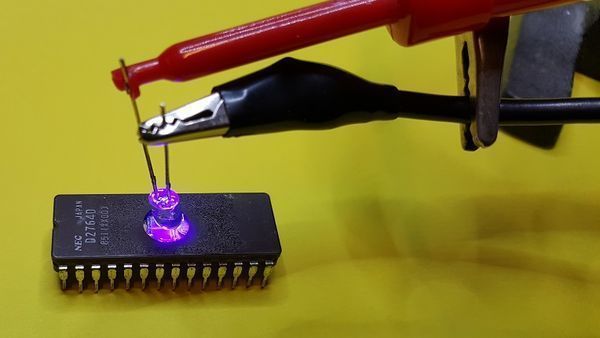
Improvising an EPROM programmer
"For a project (revitalizing a large 80’s liquid crystal display) I needed to program an EPROM. The EPROm should contain a character font that goes into the LCD so it can show characters. The EPROM required was a 2764, this is a 64 kilobit (8kiB) eraseable programmable read only memory, which is eraseable by ultraviolet light. The first problem: I didn’t have a 2764. I did have a 2716 (16 kilobit), new old stock. I bought this in 1981 or so for the Elektuur Junior computer." [...]
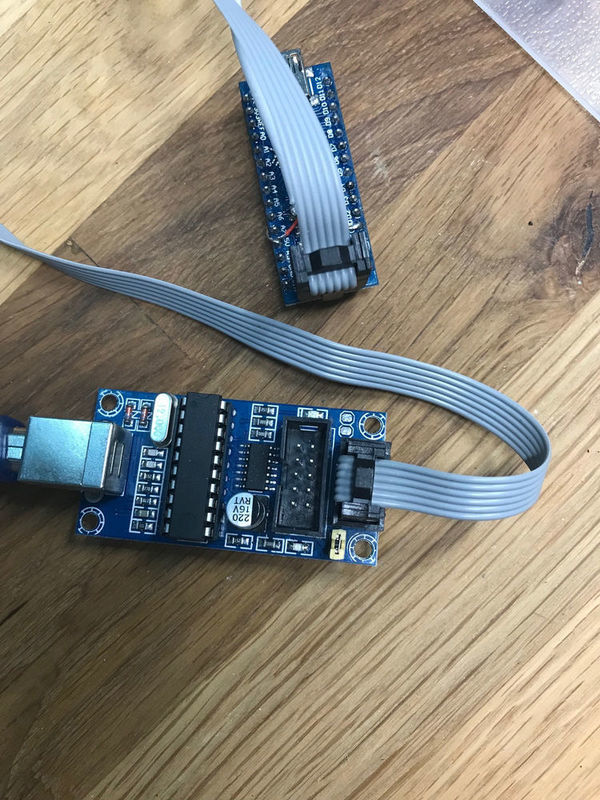
Arduino bootloader with OTA (over the air) support over nRF24L01
"As I was building my SmartHomeDIY platform (OpenSource) one of the first things I was looking for (except of debug tools and board), was a bootloader for Arduino which supports over the air flashing of the internal sketch. I needed this because I was about to mount all the Arduino board inside my wall, and I did not wanted to take them apart every time I had a bug. So the way to go, is over the air (OTA), which Arduino does not supports out of the box, so lets learn how to do exactly that. In order to get OTA working on your Arduino You will need to flash on it a special bootloader that support OTA, but not just any boatloader, you will need one specific to the type of your communication board - in my case, RF24," [...]
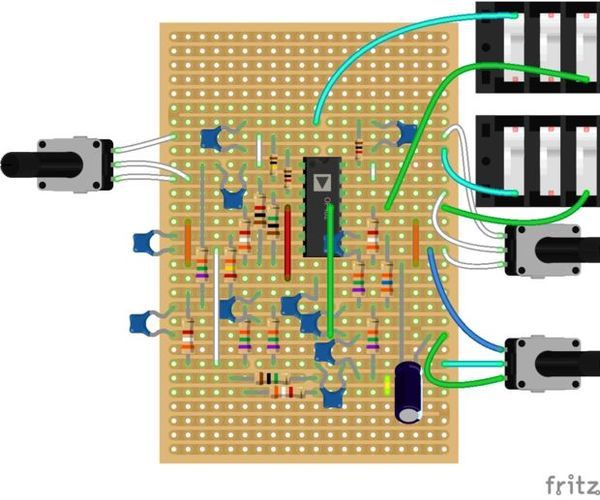
ATMega1284 Quad Opamp Effects Box
"The Stomp Shield for Arduino from Open Music Labs use an Arduino Uno and four opamps as a guitar effects box. Similar to the previous instructable that shows how to port the Electrosmash Uno Pedalshield, I have also ported the Open Music Labs Guitar Effects box to the ATMega1284P which has eight times more RAM than the Uno (16kB versus 2kB). Compared to the previous instructable using the ATMega1284 effects unit, this box has the following advantages: (1) It has a mixer which mixes the unprocessed signal with the MCU processed signal - that means that the quality of the signal at the output is much improved. (2) It does 16 bit output processing for the two PWM outputs wheras the previous effects box use 8 bits for some of the examples such as the delay effect. (3) It has a feedback potentiometer which can be used to enhance the effects - especially with the flanger/phaser effect about 30 percent feedback adds considerably to the quality of the effect. (4) The low-pass filter frequency is 10 kHz compared to the 5 kHz of the previous effects box - this means the signal at the output sounds considerably "crispier"." [...]

Arduino RFID Maze Game
"Today I'll be demonstrating how I put together a little RFID maze game for Arduino. The code and 3D print files are included, so feel free to make yourself one following the steps below! I wanted to make a toy for children, that would blend a virtual and physical experience. With this device they can scan common objects that contain RFID chips (metro cards, pets, clothes, etc) and make these objects more playful and interactive. Every time you find a new RFID chip, the arduino generates a maze for you to solve. Complete the maze and you'll hear a merry jingle through the piezo speaker." [...]
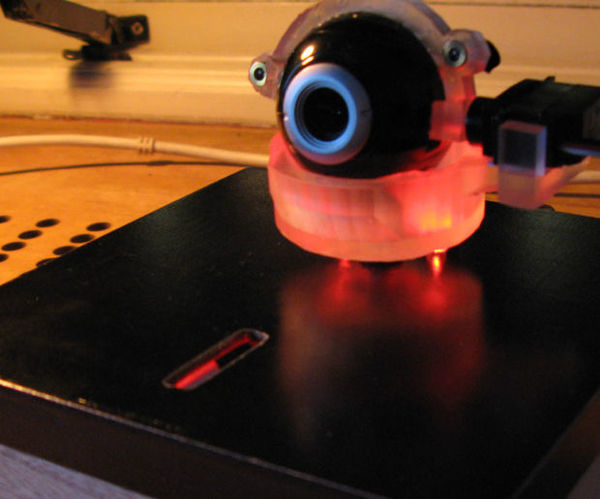
Begging Robot
"We are going to make a begging robot. This robot will try to irritate or get attention of passing people.It will detect their faces and try to shoot lasers at them. The robot will need a arduino a live feed of a camera and a computer to run openCV on. " [...]

Pumpkin Pi Digital Decoration Controller
"Hello folks, let me introduce you to the Pumpkin Pi. Simply put it is an I/O controller for the Raspberry Pi with twelve programmable outputs, but with a little hocus-pocus (or Python code to you and me) it becomes a digital decoration controller that offers two video outputs with audio, and lighting FX synced to video. The BackgroundLast Halloween I decided to create a Witching themed window display, having recently discovered AtmosFX's Digital Decorations I felt inspired to make good use of them and incorporate them into my display. I needed a way of playing back two video playlists alternately on two different displays (a TV and a projector) without the videos accidentally overlapping each other. I also wanted to integrate lighting FX to add to the atmospherics. More about the ControllerAs it was inspired by a Halloween project I felt the name Pumpkin Pi was very appropriate." [...]
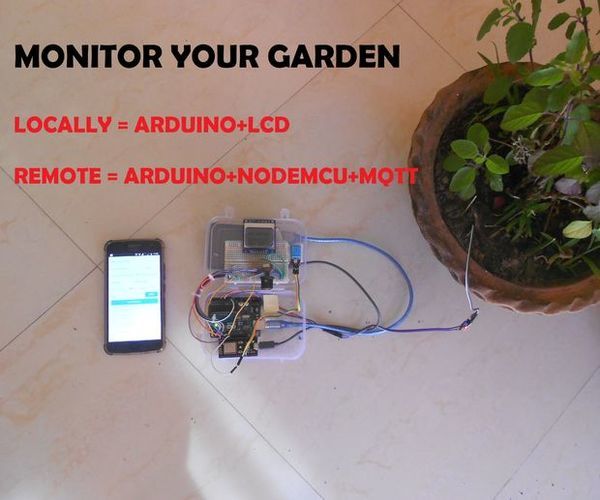
Monitor Your Garden
"Monitor Your Garden from anywhere, use local display to monitor the soil conditions locally or use Mobile to monitor from remote. The circuit uses soil moisture sensor, coupled with temperature and humidity to make aware about soil ambient conditions. " [...]
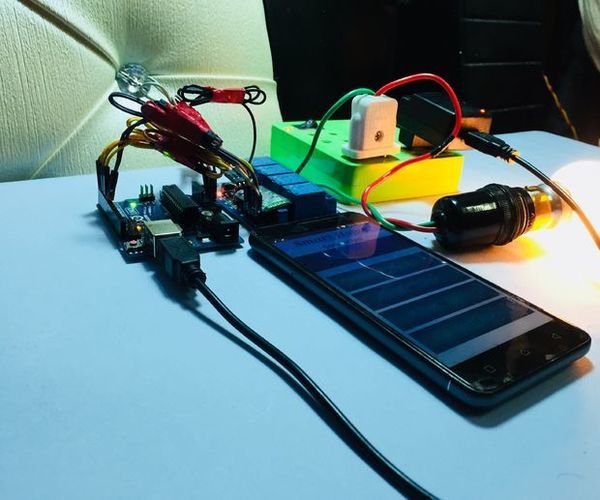
Home Automation System Using Arduino And Hc-05 Bluetooth Module
"Hey Guys How You all doing! Today I am Here With My Second Arduino Instructable. It is A Bluetooth Controlled Home Automation System.You Can Conrol Your Home Appliances Just From Your Smartphone.All the things Works Perfect ! Also I Designed The App..Please Have a Look At it. I wanted to have the information I learned in one place, and easy to Understand.Comments and suggestions are welcome and appreciated as I'm still trying to learn all this stuff. Hope You All Like It :)" [...]
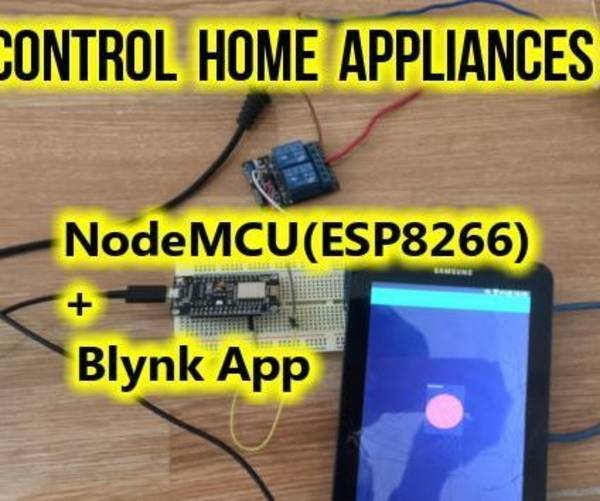
Control Home Appliances Using Nodemcu And Blynk App
"In this tutorial,we are going to learn how to use Blynk app and NodeMCU (ESP8266) in order to control lamp(any other home appliances will be just fine),the combination will be through the internet. The purpose of this instructable is to show the simplest solution remotely-controlling your Arduino or compatible hardware (NodeMCU) over the Internet and to explore the world of Internet Of Things(IoT). What's Blynk ?Blynk is a Platform with iOS and Android apps to control Arduino, Raspberry Pi and the likes over the Internet. Its a digital dashboard where you can build a graphic interface for your project by simply dragging and dropping widgets. (Source : Blynk website). " [...]

Gps Forest Fire Alert System With Sim808 And Arduino Uno
"Hello that, in this post we will see how to make a forest fire detector system, with notification by text message, of the location of the accident, thanks to the integrated gps sim808 module, granted by the people of DFRobot, we will see the source code, some characteristics and operation of sim808 module, in an external environment, this is the continuation of a previous project, where we saw how to make a very simple flame detector system for the home. " [...]
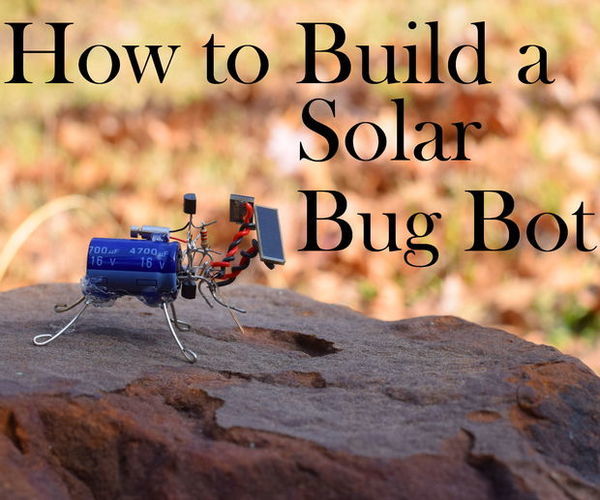
Make A Solar Powered Bug Robot
"These robots might be small and somewhat simple minded, but their easy construction, unique locomotion, and quirky personality make them great as a first time robotics project. In this project we will be creating a simple bug-like robot that will store light energy until it has enough power to move itself with a vibration motor. This simple robotics project can be done in a few hours and it is an excellent introduction to the concepts of electronics and soldering. " [...]
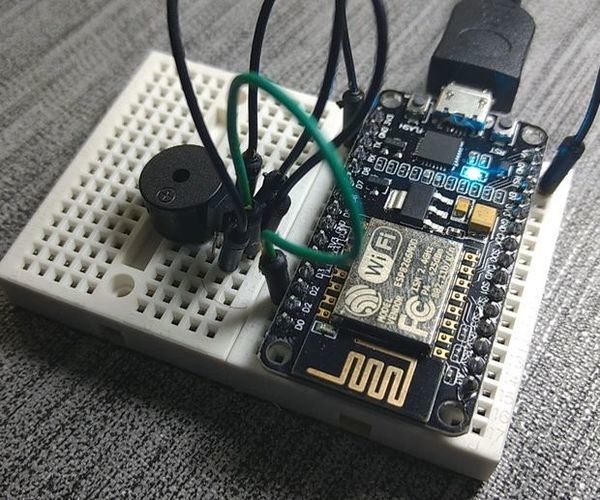
Realtime Event Notifications Using NODEMCU (Arduino), Google Firebase And Laravel
"Have you ever wanted to be notified when there is an action made on your website but email is not the right fit? Do you want to hear a sound or a bell every time you make a sale? Or there is a need for your immediate attention because of an emergency at home? This device can alert you in real time about anything you like. " [...]
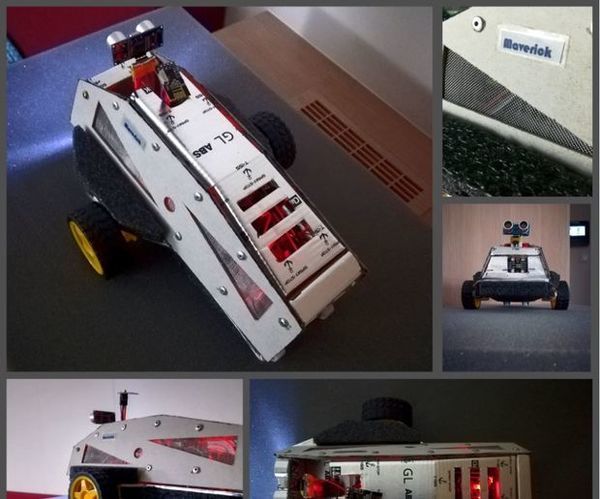
Maverick - Remote Controlled Bidirectional Communication Car
"Hey everybody I'm Razvan and welcome to my Maverick project. Ive always liked remote controlled things, but I never had a RC car. So I decided to build one which can do a little bit more than just move. For this project we will use some parts which are accessible to everyone who has an electronic store nearby or can buy things from internet. Im currently onboard a vessel and I dont have access to different kind of materials and tools so this project will not include a 3d printer, CNCs or any fancy devices (even I think it will be very useful but I dont have access to such equipment), it will be done with much simpler tools available. This project is meant to be easy and fun." [...]
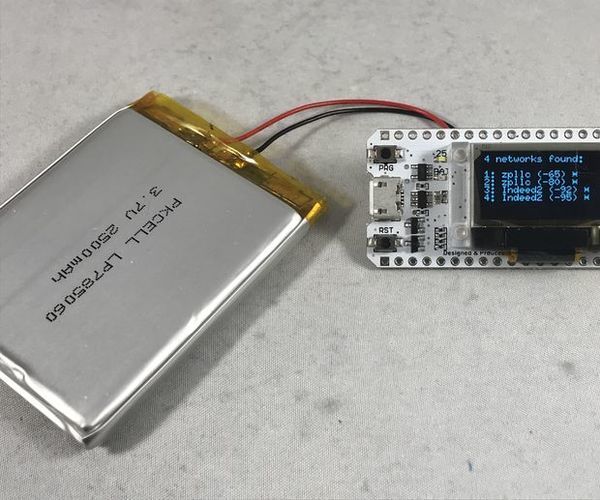
Heltech Wifi Kit 32 Based Network Scanner
"After having difficulties with the Adafruit Feather ESP32 and static discharge sensitivity, I needed to find a suitable alternative for my previous, current and future ESP32 based projects. After testing a variety of ESP32 boards (none of which exhibited the static discharge sensitivity), I ultimately selected the "Heltech WiFi Kit 32" board (available on line). The board features a micro usb port for programming and charging, a JST 1.25 mm 2 pin connector (note this connector is smaller than most JST connectors I've used) and charger for a lithium battery , wifi, bluetooth, and an on board 128 by 64 OLED display, all for around $17.00 USD. My first project for this board was to port a wifi network scanner I had developed for previous projects (the source code for the port is included as an Arduino .ino file). Most of the display samples I located for this board utilized a software implementation for I2C communication with the OLED. The included source code uses the hardware I2C for communication with the OLED." [...]
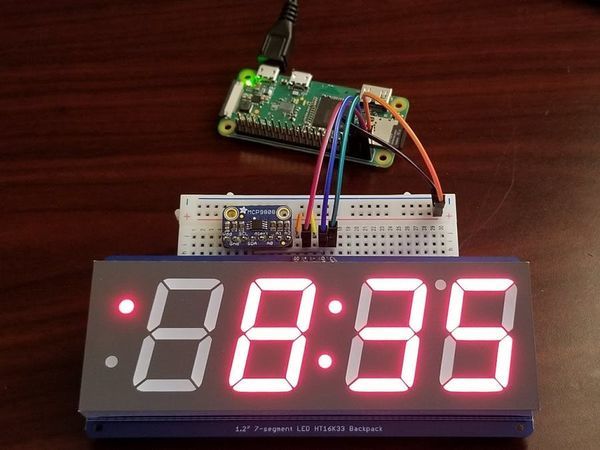
Raspberry Pi Clock with Temperature
"A Raspberry Pi clock with outside temperature display using OpenWeatherMap and inside temperature display using a MCP9808 sensor. This project is for a building a digital clock that includes temperature display. It uses OpenWeatherMap to retrieve outside temperature information and a MCP9808 sensor for inside temperature. The assembly is fairly simple and requires the following components: - Raspberry Pi Zero W - Adafruit 1.2" 4-Digit 7-Segment Display w/I2C Backpack - MCP9808 Temperature Sensor Breakout Board" [...]

How to Build Your Own Function Generator Using Analog Devices' AD9833
"Learn how to make your own arbitrary waveform generator using an ATmega328p, a DDS function generator IC, an op-amp, a few passives, and some hard work. Having your own electronics laboratory at home is great—the only downside is that even basic equipment can be costly. Building your own devices is not only easier on your wallet, but it is also a great way to improve your knowledge. Therefore, in this article, I am going to explain how to build your own function generator. What is a function generator? First, a function generator (also called a tone generator) is an electronic device that can output a specific waveform at a set frequency." [...]
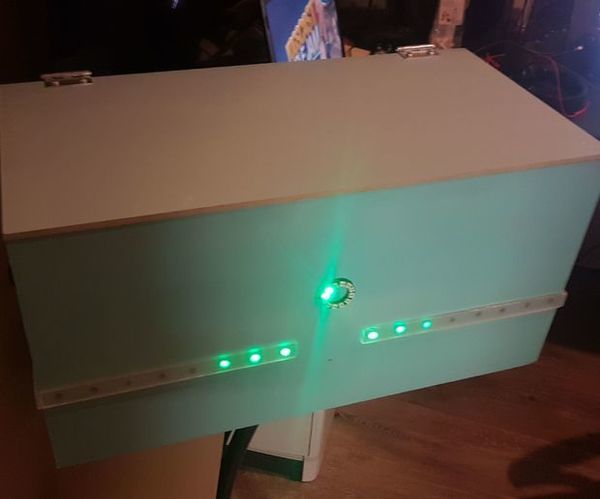
Lock Using Sonars And Led Strips On Arduino
"For this project I made a box that opens by using sonars, LED strips and 1 servo motor. The main idea behind this is that you use two sonars that both have a "sweet spot". If you hit both these sweet spots the servo moves and opens the lock. The LED's are used to visualize the sweet spots. For this project you will need: 1 Neopixel strip that's 1 meter long with 30 LED's in total 2 HC - SR04 Sonars 1 Neopixel LEDring with 12 neopixels 3 220 OHM resistors 1 arduino UNO A breadboard Wires 1 box" [...]
That's all Folks!


